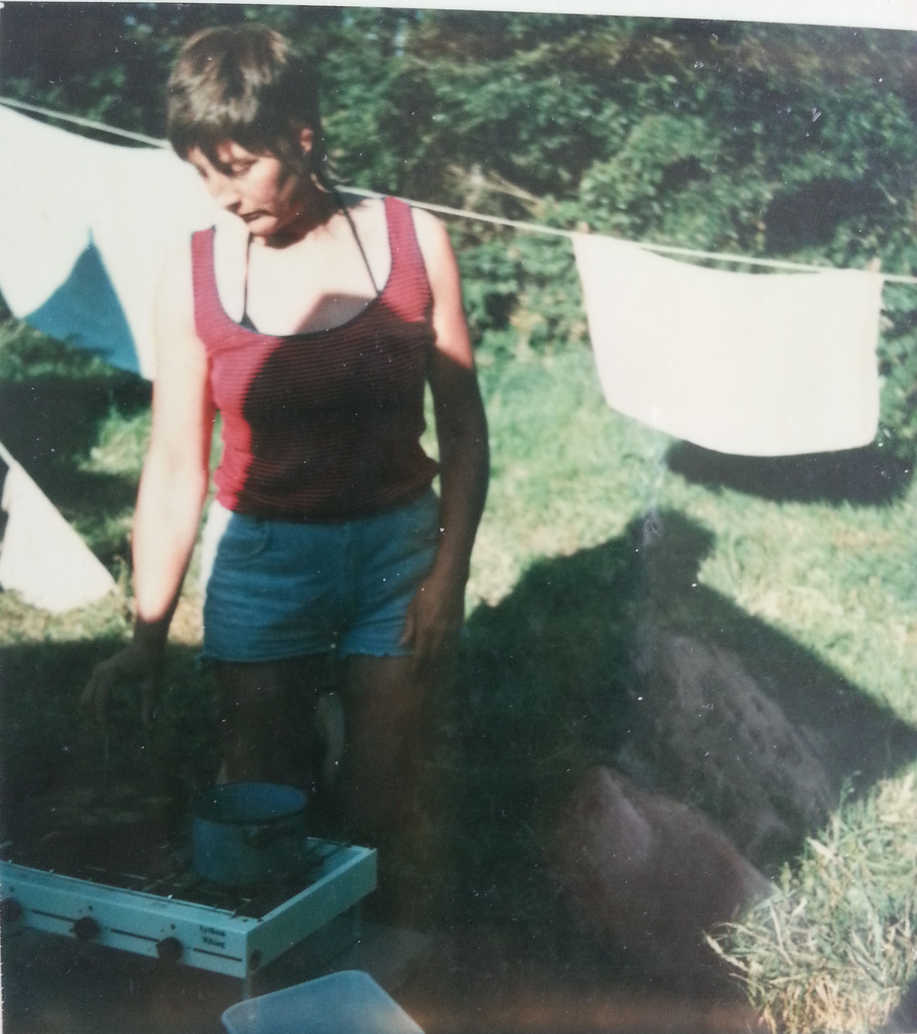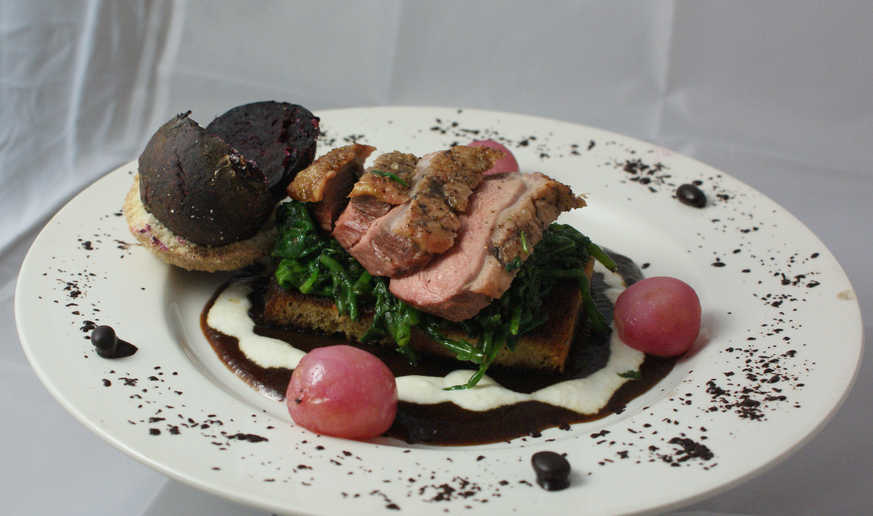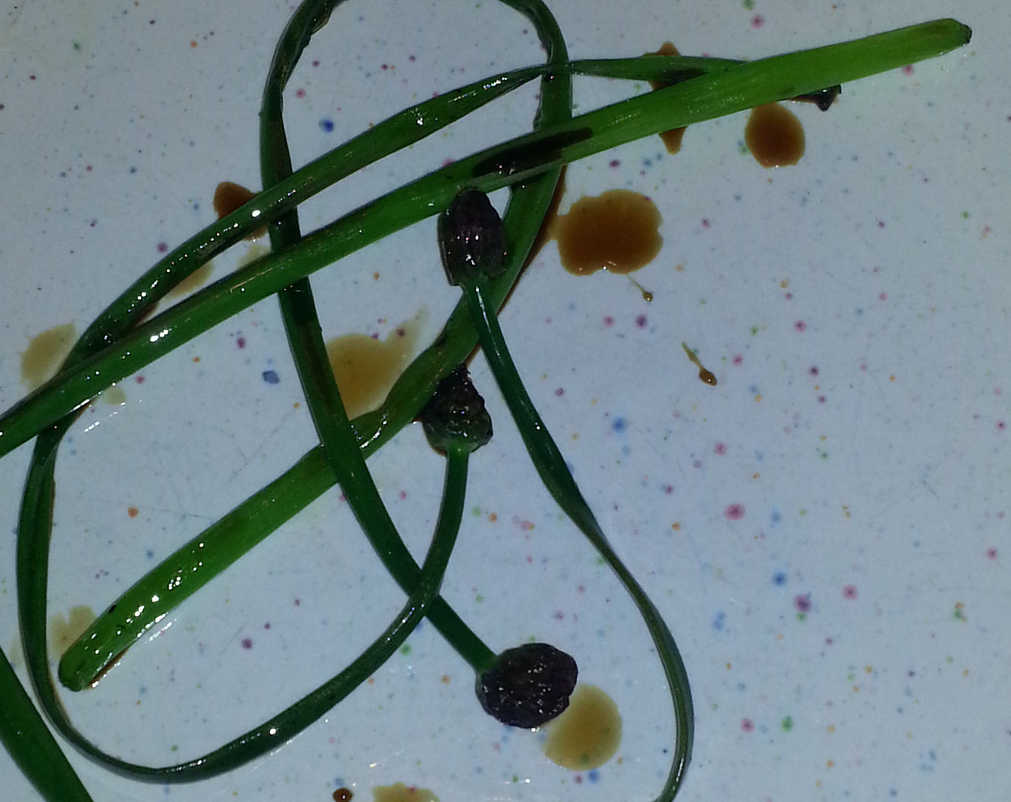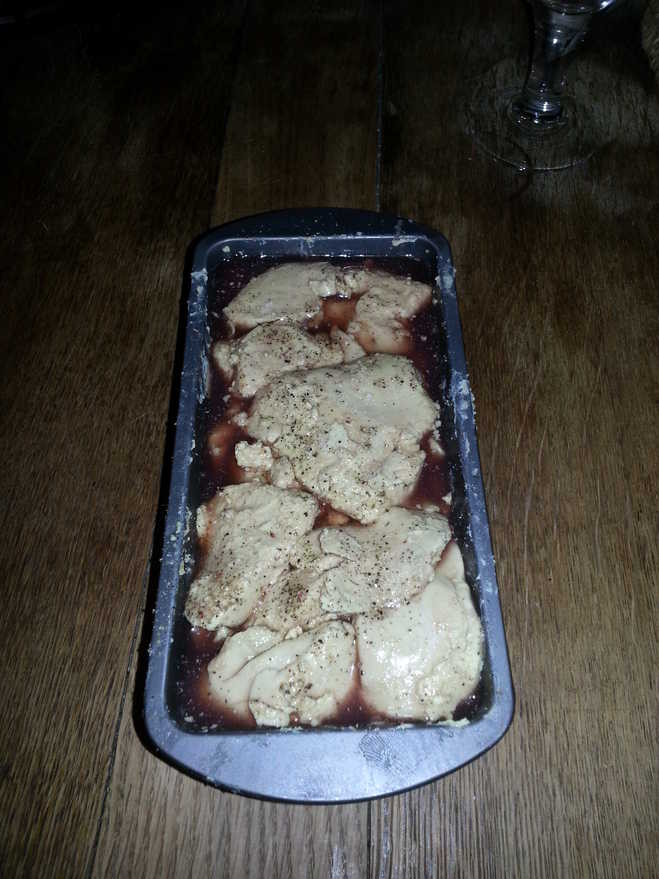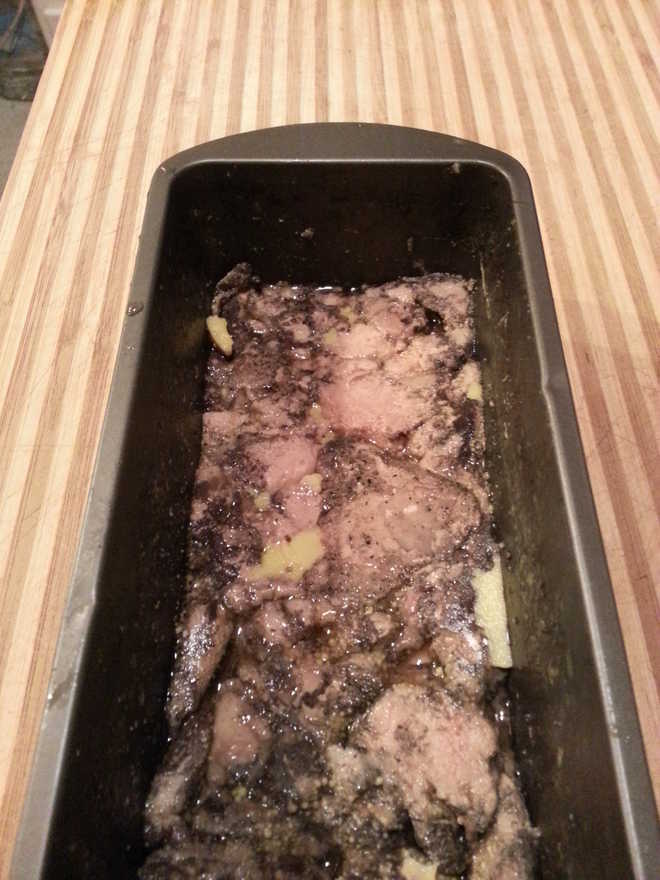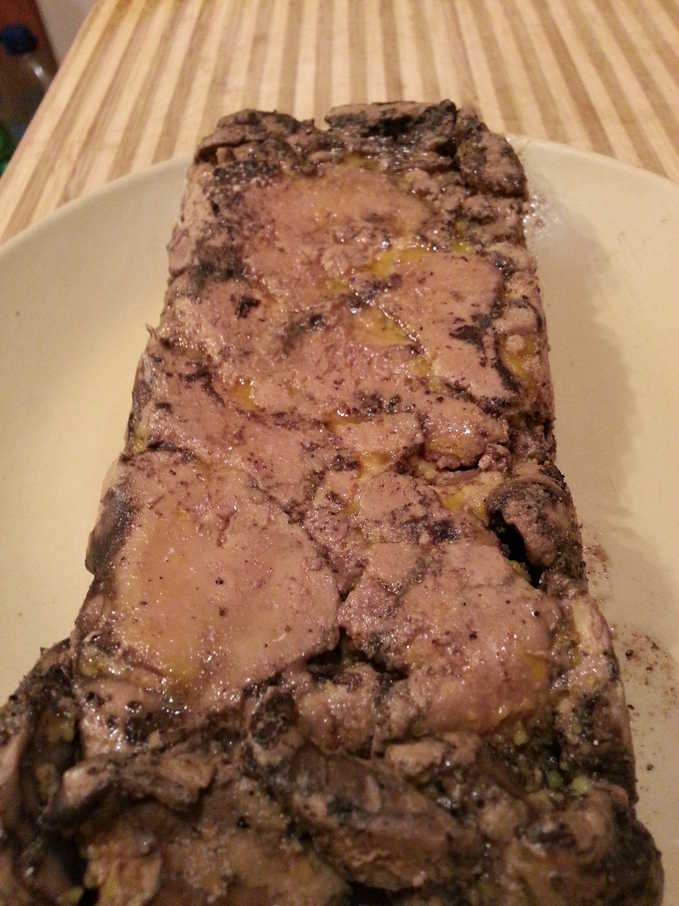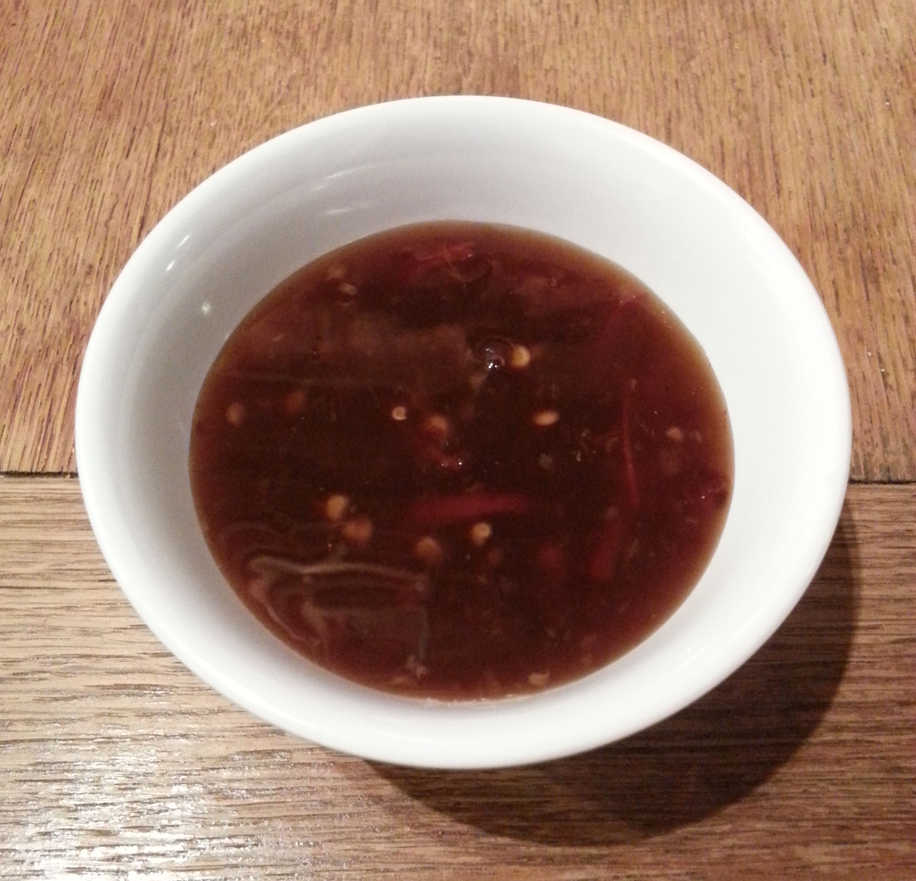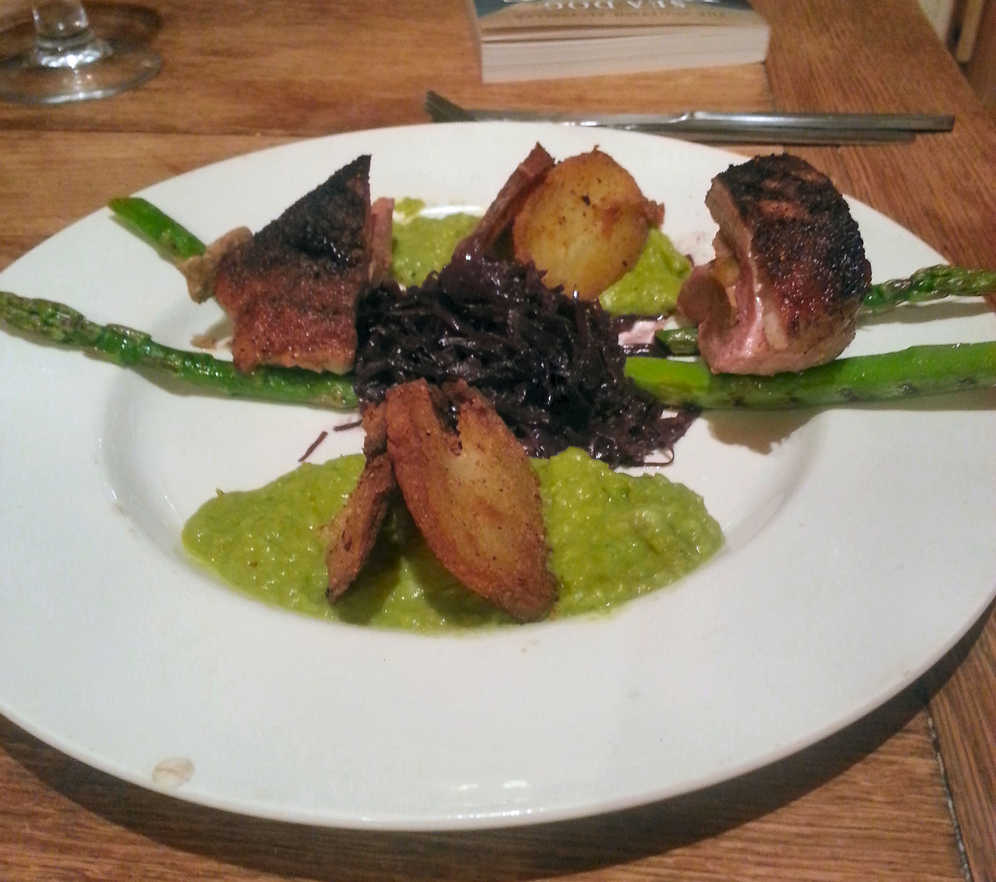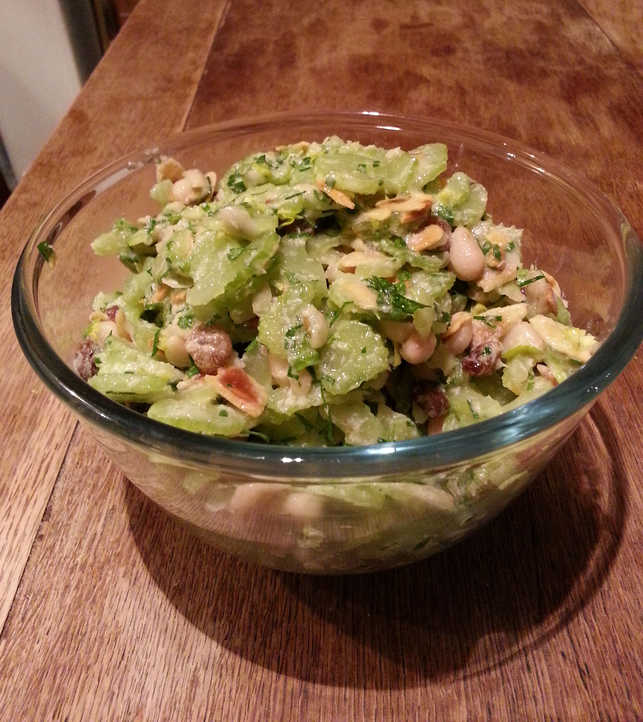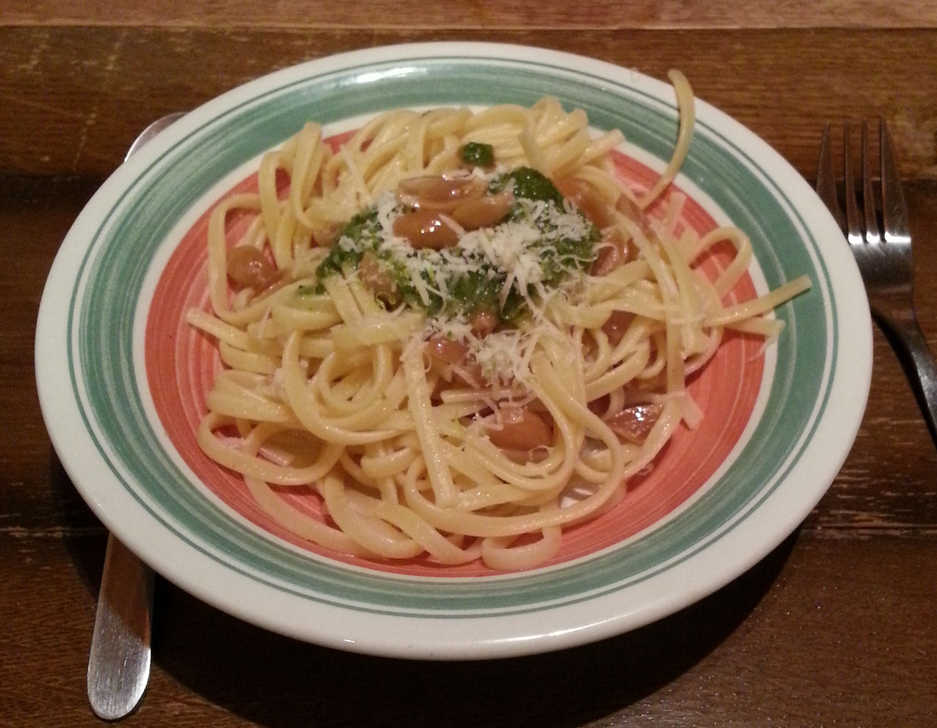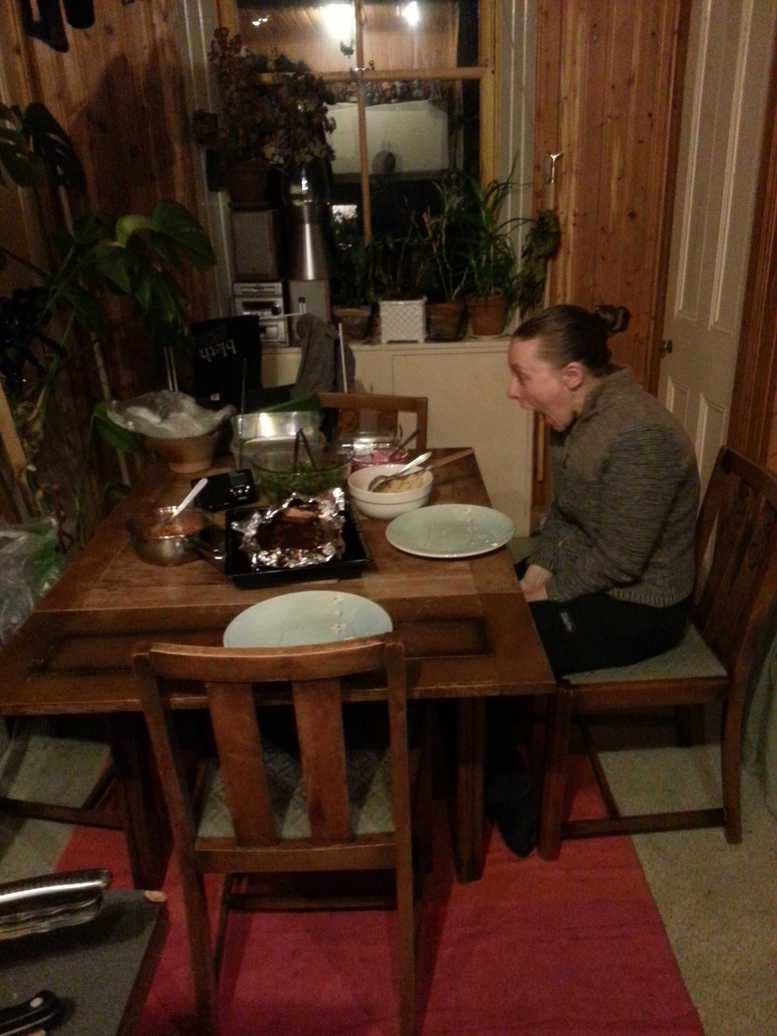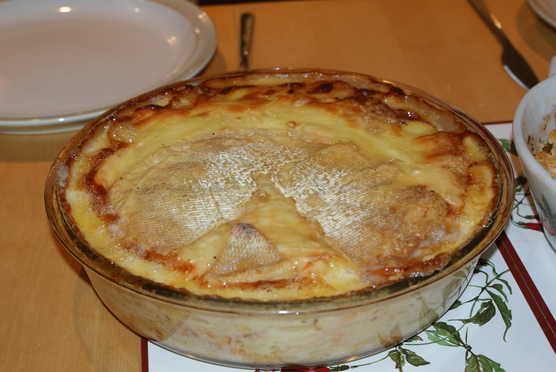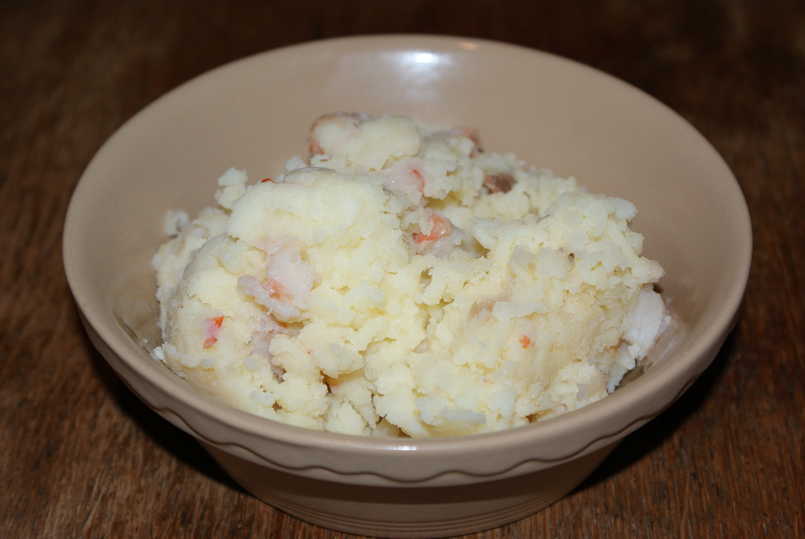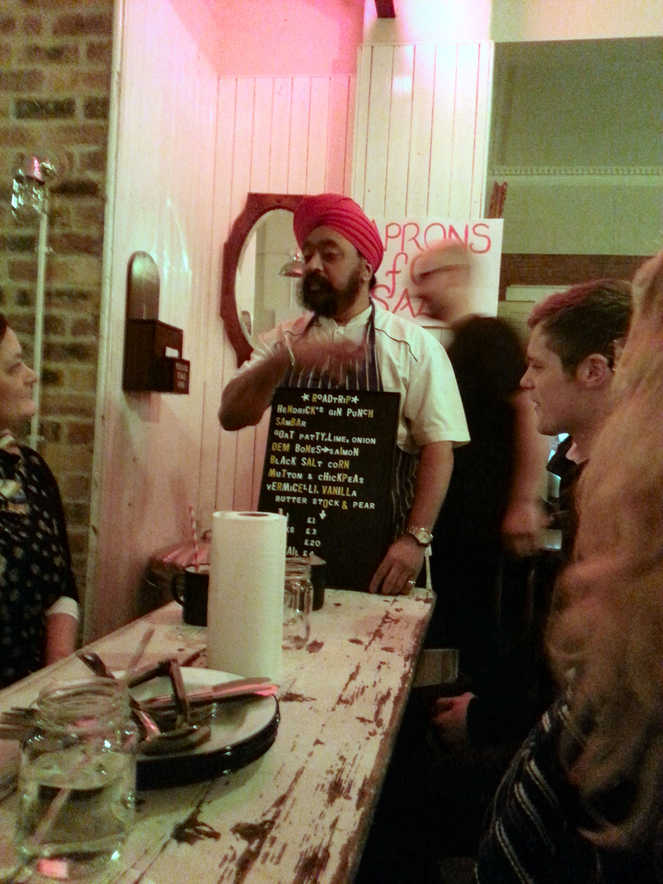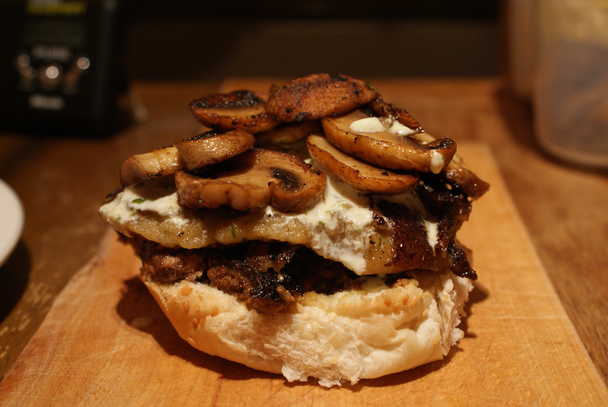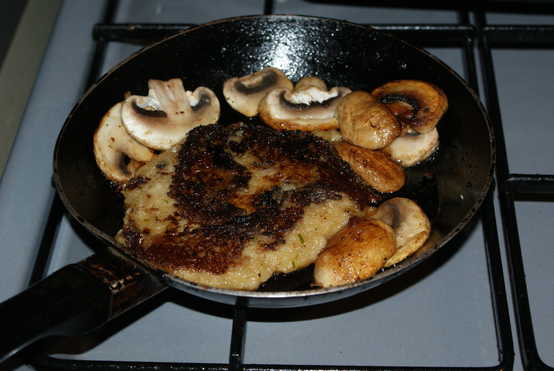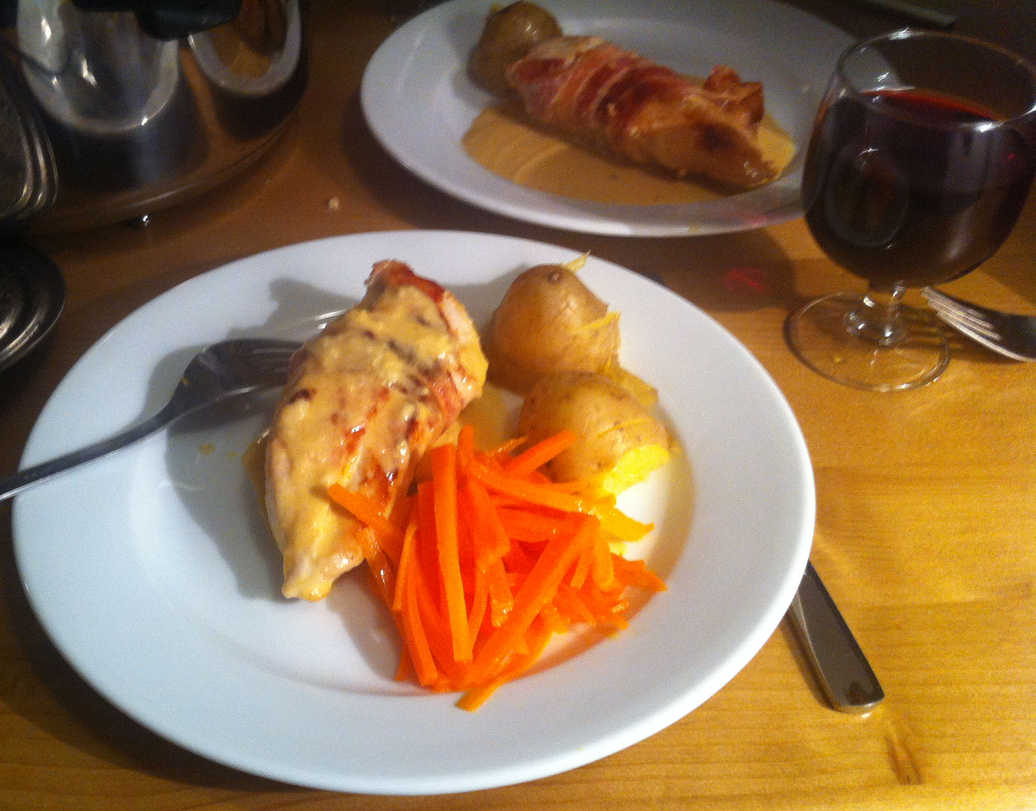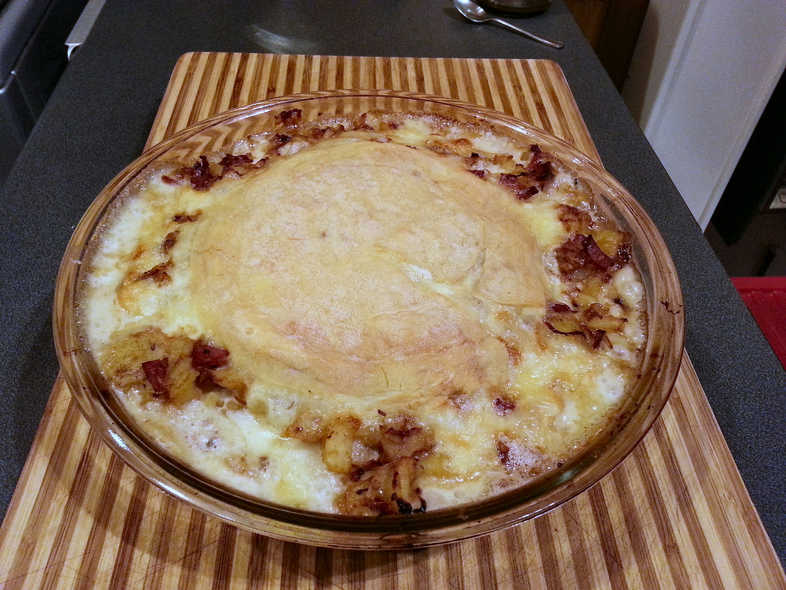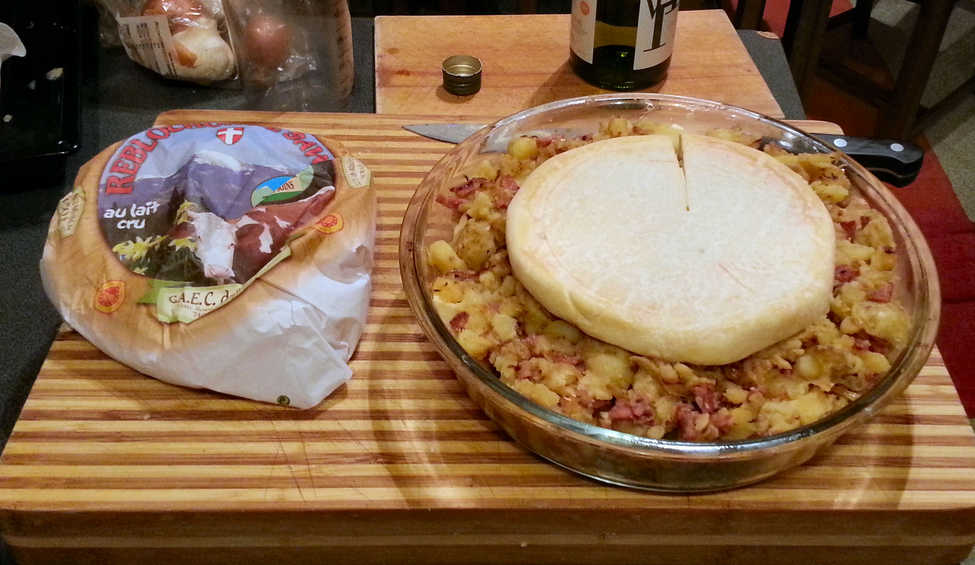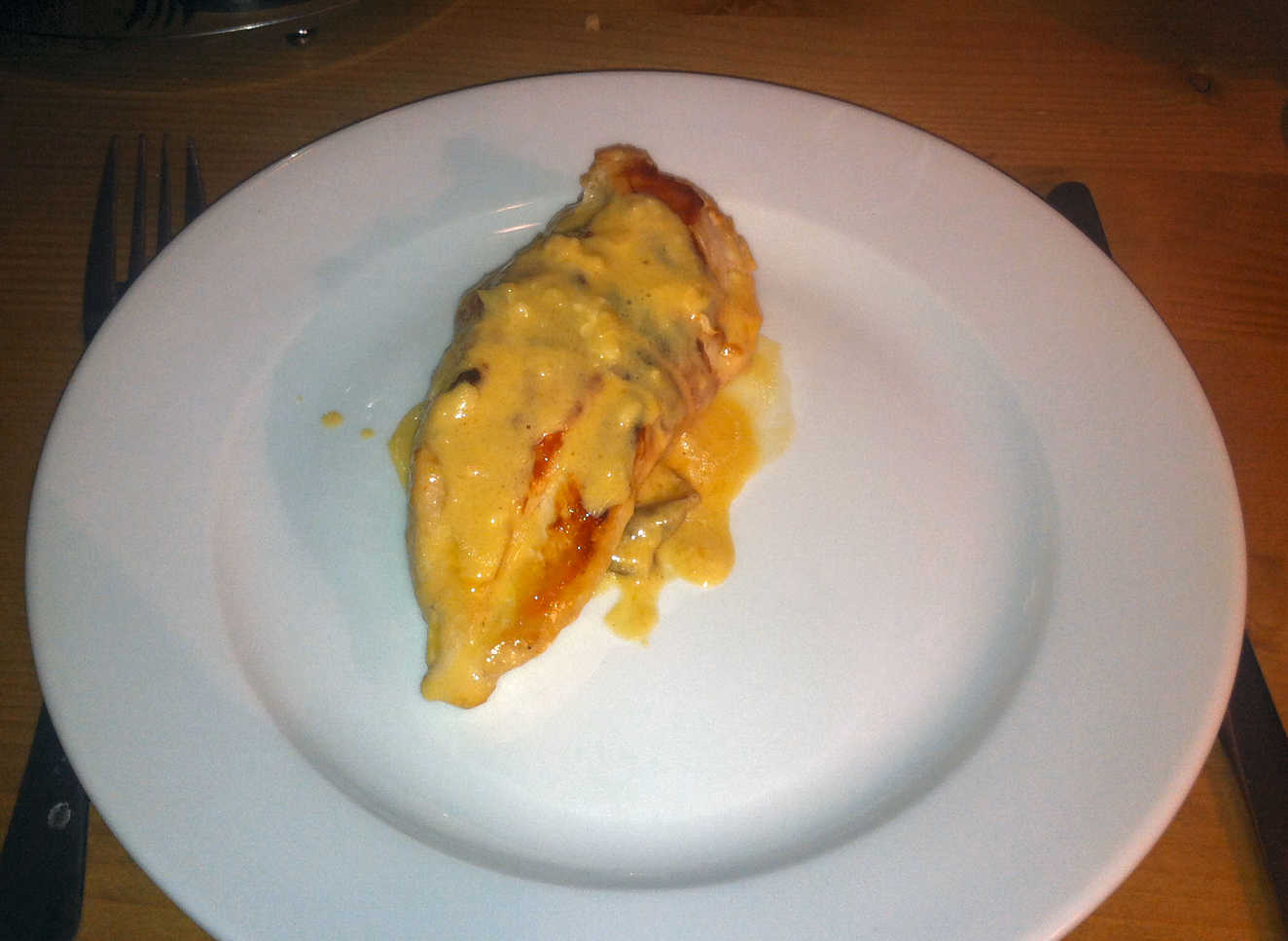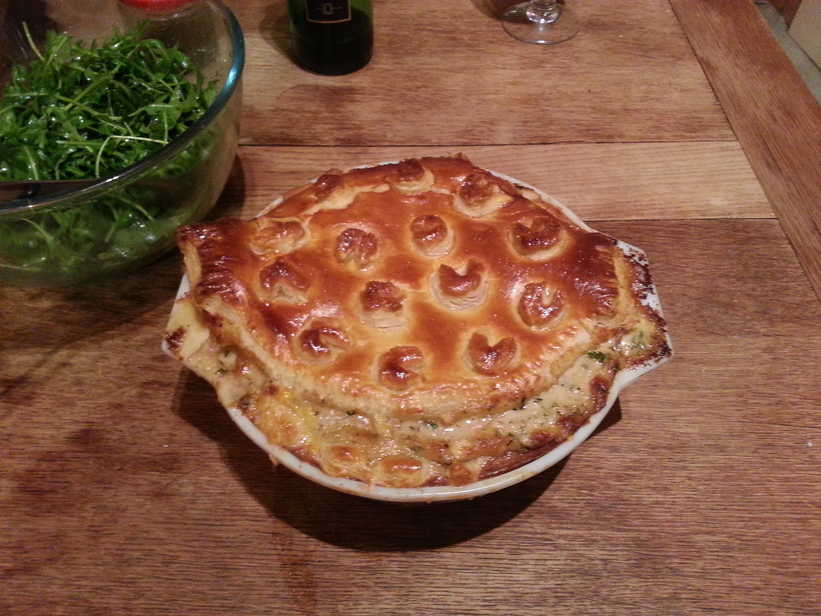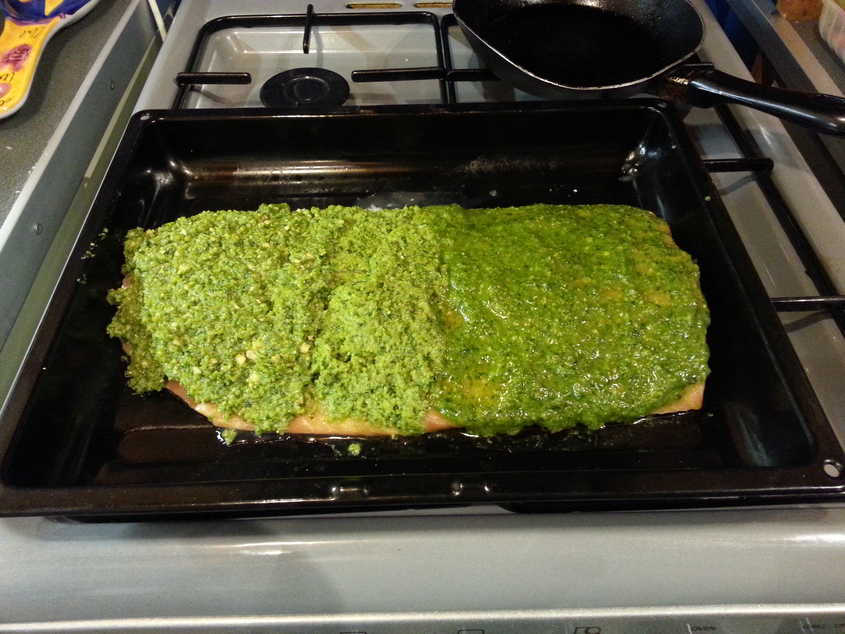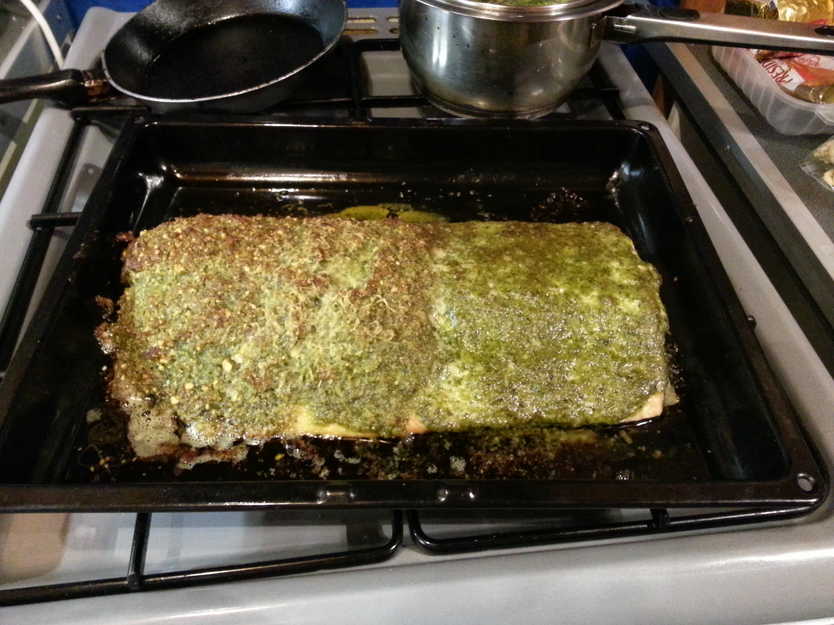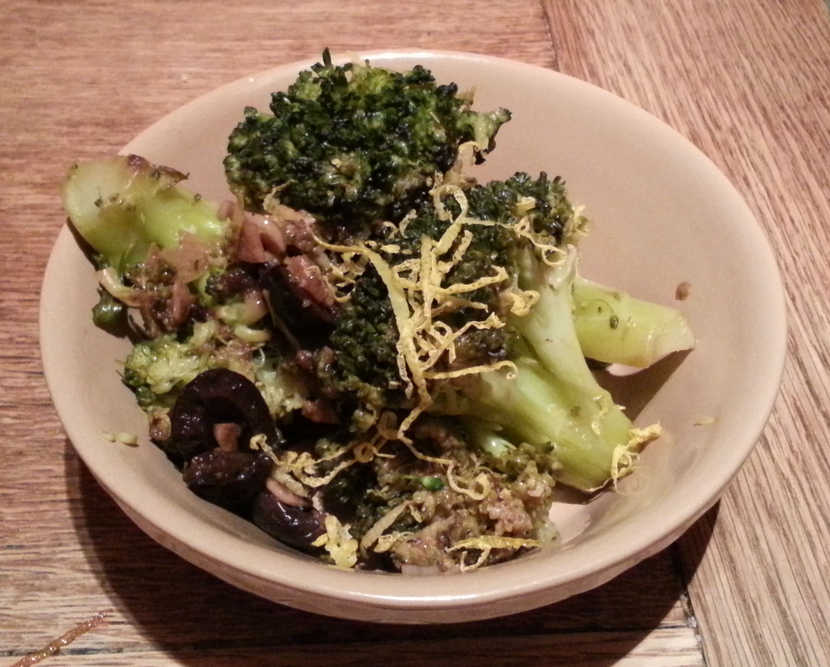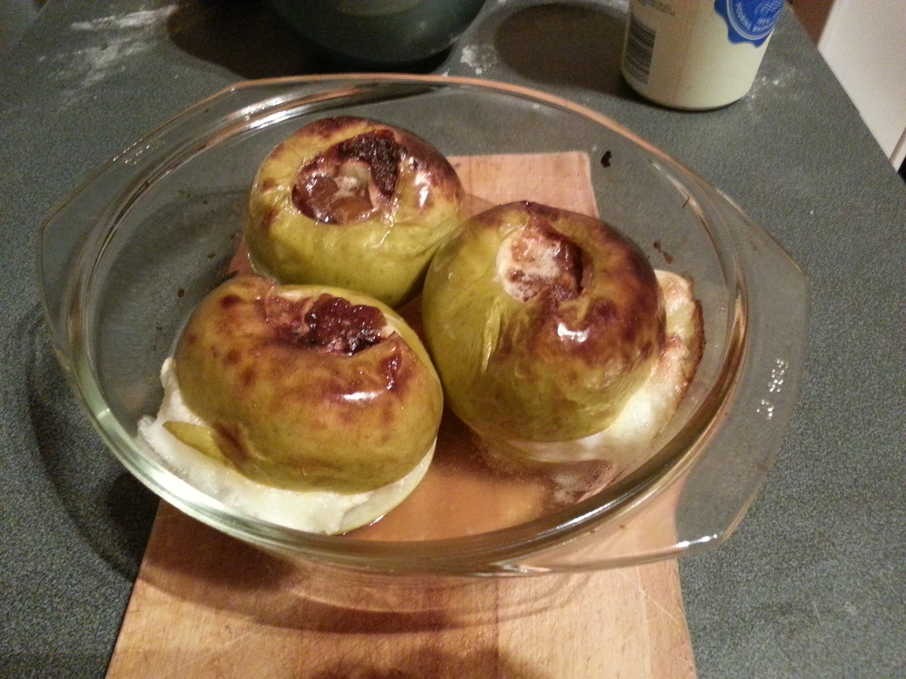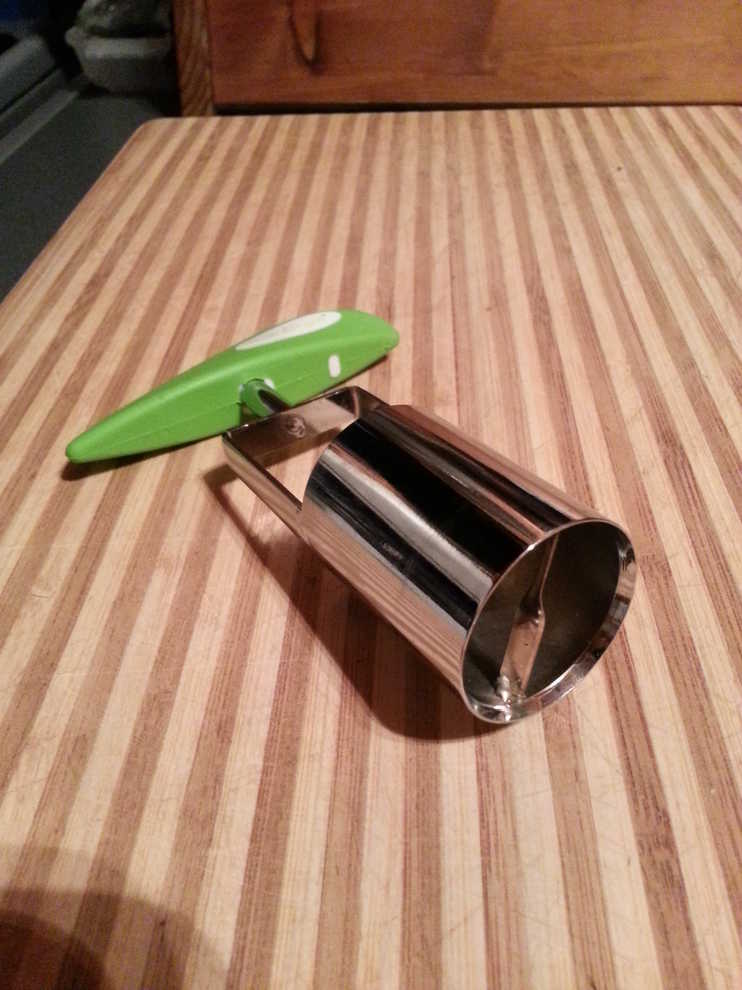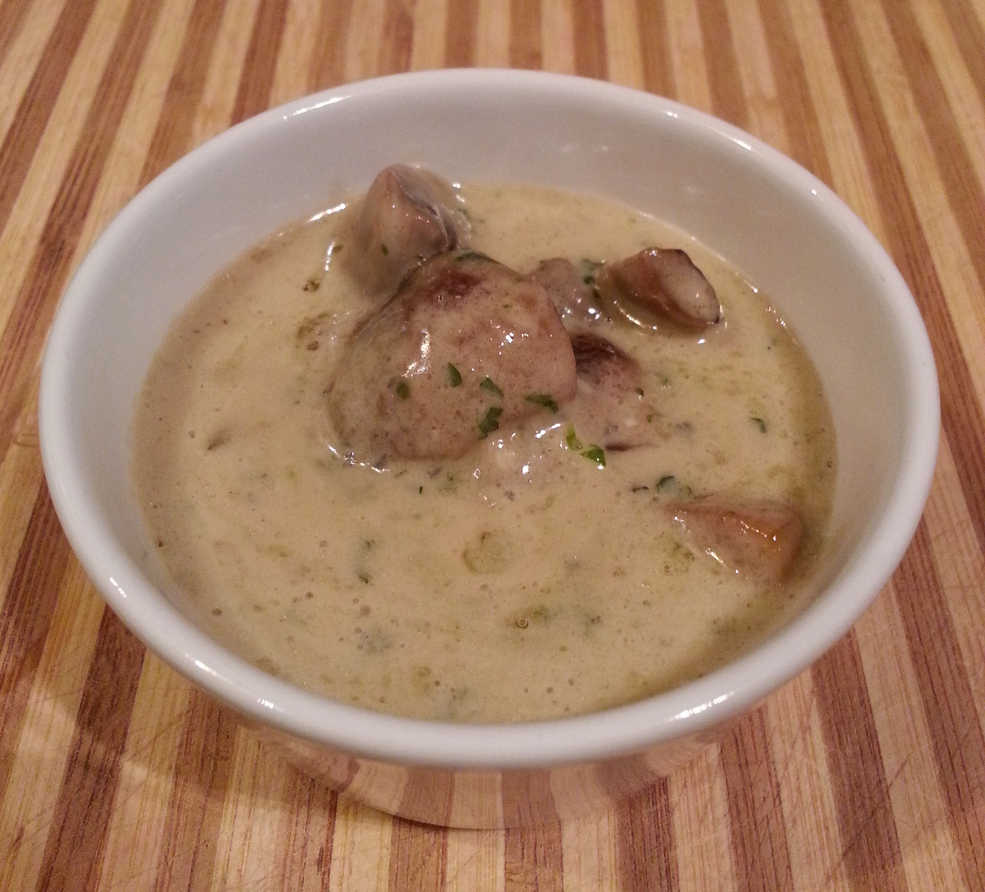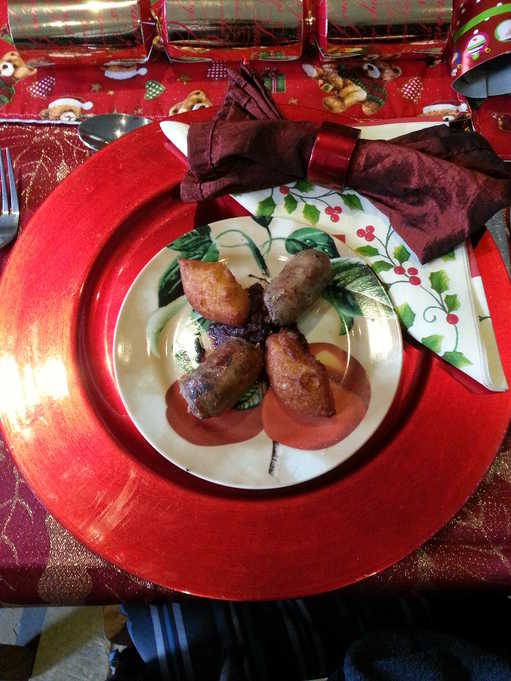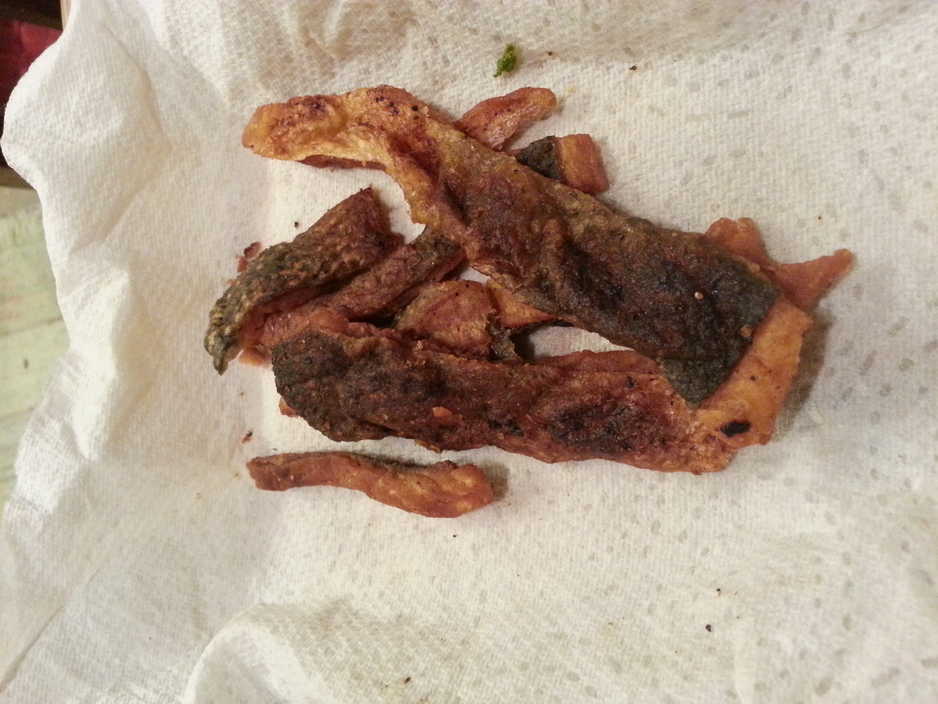
Cooking With Mother No More

Mum died.
She was diagnosed with aggressive and widespread cancer back in March, and fell steadily downhill afterwards.
I'm grateful I had the chance to tell her You did good, Mum.
Mum wasn't much of a cook I'm afraid, though she did get better - I like to think with a bit of encouragement from yours truly :)
She was a genius for getting the dinner onto the table in time for the Archers though - every day growing up; sit down for dinner, on comes the Archers.
I have no idea how she did that!
While I don't honestly remember spending much time actually cooking with Mum (well until our famous joint Christmas dinners in recent years - she did the best Christmases), she was the one who first started me off cooking and always supported my cookery even back when it wasn't exactly fashionable for young boys to be spending too long in the kitchen. She bought me my first cookbook, shared all her best recipes, and most of all shared my deep love of food.
Apart from our mutual enjoyment of murder-mystery TV series like Marple or Poirot, the things we could most bear to do together without driving each other mad were watching episodes of MasterChef, and eating out in fine restaurants.
Most of my foody memories of Mum revolve around the kitchen of the house we moved into when I was twelve. The house I most remember growing up in. Mum's last house. The house we had to clear after she died.
It's particularly difficult for me to look at the photo of Mum proudly showing off her new cooker there - when we first moved in to the house the kitchen sported an old Victorian range, and much as I hated having to clean it out every day, riddle the ashes, and fetch coal from the yard to feed it I kind of missed Mum cooking on it when she finally got her real stove and had the range pulled out.
The cooker is still there though.
For now.
Mum's passing has left a hole in the world.
I know that eventually time's sand will fill it, but it will never quite disappear - there'll always be a hollow there.
Where my Mum used to be.
Bye Mum.
Comments (1)
Coffee, Chocolate & Fishy Duck

The duck's not really fishy of course Wait a minute - is that an idea? Fishy duck? No. No, it really isn't. Of course not. As you were... it's just the first course that's fishy.
But the duck is coffee-ey and chocolate-ey.
There were quite a few inspirations for this meal - it's been such a long time since I did any cooking what with running up and down to visit poor old Mum in the hospice (Moominmamma - as my good friend Becky called her), that I suppose I've had a lot of these ideas rattling around in my head.
The fish course comes straight from The Star Inn (a handy watering hole on my trips South) where I had soused mackerel packed in a little jam jar with a beetroot relish.
Delicious.
It wasn't until I made the version below that I realised theirs was more like a raw pickling method than this cooked one, but mine was nice enough for all that.
My friend Doctor Jenny once rhapsodised about their braised radishes when she went to visit the venerable Peat Inn and I fancied having a go at them.
I also remember someone else banging on about baking salt-crusted vegetables - apparently it's all the rage on one of those ghastly cooking competition TV shows - Britain's Got Chefs or whatever, so I thought I'd have a go at those too.
But then that set me thinking about what else you might bake crusted in salt (chicken works apparently?), and then naturally onto what else you might use to pack around yer baking goods.
Now it just so happens that I've had a sack of coffee beans rolling around in the bottom of the freezer I've been trying to empty forever now (so I can get a new one), and needed something to do with them other than making coffee.
I'd thought of baking or steaming fish with them, and had more-or-less dismissed the idea of using duck or chicken, especially breasts, because of the problem of them drying out during the roasting.
I mean - who just roasts duck breasts? No one that's who. Well, until now.
The idea of using the coffee beans from frozen to stop the duck drying out seemed like a stroke of genius. Or madness.
Either way I grabbed onto the idea with both hands et voilà: coffee roasted duck breasts are born.
menu
Garlic Escape

Garlic scapes are those eccentrically curly flowering stalks that grow out of garlic bulbs in the springtime - amusingly described as looking like a cross between a plant and an octopus.
If you're lucky you might come across bunches of them in a farmers' market. On the other hand, if you happen to have shuffled your Mum off to a respite hospice you might find them growing in one of their sheltered and well-tended gardens from where you can pluck a handful unobserved.
You can serve them up quickly cooked on their own as a side dish or starter, use them in pesto, soup, add them to a stir-fry, serve them with pasta or chop them into salads. They taste a little harsh raw, but the flavour mellows surprisingly when cooked.
When not stealing garlic scapes from Marie Curie, I've been popping into The Star Inn on my way to and from visiting Mum (though it turns out that Harome is not that close to the A1 and includes some pretty crappy roads).
I got to try their famous Black Pudding and Foie Gras combo and after complimenting him on the surprising crispness to his fried foie gras, that nice Mr Andrew Pern gave me a few pointers for getting my weeping, saggy livery pillows to turn out something more like his:
- it's essential you begin with slices of fresh, high quality foie gras
- get your pan blistering hot to seal the liver
- let the slices gently cook through to completion at a lower temperature
You might consider scoring the first side to cook too, or even dusting with flour to generate that extra crustiness.
Not only was his foie gras exquisite, but his accompanying reduced apple chutney was thinner, but crunchier than mine, suggesting that I'd reduced mine a little too hard. I wondered too if he might have added a second round of cubed apples after reducing, to maintain a level of fresh crispness whilst still managing to generate such plentiful rich jam?
To top everything off, Andrew's decorative apple slice was beautifully caramelised using a blowtorch too - rather than pan-frying as I had. I think that gives a better-looking result.
Anyhoo, I also had a fantastic Tournedos Rossini there for dinner, served with their own paté de foie gras, which inspired me to make up some of my own. With mixed results.
I'm going to have to do a lot better than this if I want to serve my own Rossini!
Charred Garlic Scapes
veg vegan starter side
You can griddle, fry, or grill these little fellows.
Toss them in a little olive oil first then cook them until they char in spots - like a discerning man's asparagus.
Ingredients
- garlic scapes
- a little olive oil
- salt & pepper
Dressing:- lemon juice and zest
- or
- balsamic vinegar
- or
- soy sauce
Trim the scape ends if necessary and toss them lightly with olive oil and salt and pepper.
Fry or grill them, turning half way through, so they have a few charred spots and just start to wilt.
Serve them dressed with lemon juice and a little zest, or a drizzle of fine balsamic vinegar.
Fry or grill them, turning half way through, so they have a few charred spots and just start to wilt.
Serve them dressed with lemon juice and a little zest, or a drizzle of fine balsamic vinegar.
The balsamic vinegar I used was a little sweet - given how mild the cooked scapes are.
I'd use an edgier one next time. Soy sauce might work too.
Paté de Foie Gras. Or is it a Terrine?
starter fowl experimental
I decided to have a go at making my own paté (or more accurately terrine) of foie gras, with mixed results.
I combined a few different approaches that I found, especially the one in The Cook's Book, but there's quite a lot of variation of flavourings (onion/garlic/herbs/spices) and alcohol (Armagnac, calvados, Sauternes) as well as cooking techniques. One approach which might be a useful fallback since it offers a bit more temperature control poaches half the liver and passes it through a sieve then presses it into a layered terrine together with pan-fried slices of the other half.
I combined a few different approaches that I found, especially the one in The Cook's Book, but there's quite a lot of variation of flavourings (onion/garlic/herbs/spices) and alcohol (Armagnac, calvados, Sauternes) as well as cooking techniques. One approach which might be a useful fallback since it offers a bit more temperature control poaches half the liver and passes it through a sieve then presses it into a layered terrine together with pan-fried slices of the other half.
Well it turns out I was doing it all wrong!
But I've got it sorted now and on only the second attempt too!
Good news for my wallet!
Makes about 500g
Ingredients
- 1 forced duck or goose liver
- 80ml port calvados or Sauternes are also popular
- 80ml cognac
- ½ tsp salt
- grinding of pepper
- a grating of nutmeg optional
Pick of outer membrane and de-vein the liver.
Season the livers and arrange in a terrine, pouring the liquor over each layer. Use outer slices for the top and bottom layers. Cover with cling film and refrigerate for 5-6 hours.
Cook the terrine in a roasting pan half-filled with warm water in a preheated oven for 20-30 minutes.
Remove from the oven and lay a piece of foil-wrapped card or plastic (the foie gras container seemed ideal) on top of the liver. Weigh down with tins or water-filled jam jars to press the paté firmly. Leave to set in the fridge for 24 hours, and up to a week.
I tried to do this by slicing one lobe horizontally into thirds (whilst chilled - dip your knife in hot water),
then allowing it to come to room temperature in a bath of milk and chasing out the veins with a toothpick and my fingers.
- I'd read that soaking in milk softened the liver.
I'm not so sure if the soaking, or the slicing really helped. Next time I think I'll try just gently prising the liver lobes open at room temperature to get at the veins.
I'm not so sure if the soaking, or the slicing really helped. Next time I think I'll try just gently prising the liver lobes open at room temperature to get at the veins.
Season the livers and arrange in a terrine, pouring the liquor over each layer. Use outer slices for the top and bottom layers. Cover with cling film and refrigerate for 5-6 hours.
I packed the liver into a small loaf tin, pouring in a seasoned mixture of 80ml port and 80ml Armagnac as I went.
There was a lot of liquid washing around in my final pressed paté though, so I wonder if I should have drained the excess marinade away before baking.
I left mine marinating for 24 hours (due to force of circumstance), and the alcohol flavouring was far too strong. Also the paté took on a very unattractive, dark, speckled colour from the port.
There was a lot of liquid washing around in my final pressed paté though, so I wonder if I should have drained the excess marinade away before baking.
I left mine marinating for 24 hours (due to force of circumstance), and the alcohol flavouring was far too strong. Also the paté took on a very unattractive, dark, speckled colour from the port.
Cook the terrine in a roasting pan half-filled with warm water in a preheated oven for 20-30 minutes.
OK, this is where things get confused - opinions vary about the cooking time and temperature.
The Cook's Book
suggests cooking at 150°C/300°F/Gas 2 for 20 minutes.
I thought this seemed a tad hot, so I experimented a little to find the gas setting which would hold a water bath at 70°C in my oven (middle shelf at the lowest setting). I then allowed my loaf tin to come up to room temperature, stuck a meat thermometer into the centre, placed it in the water bath and baked it for about 1 hour until the centre reached 65°C. (Actually I initially turned the heat up to Gas 2-3 for about 20 minutes to make sure the water came back up to temperature, before turning it back down to low. But I'm not sure that helped.)
I thought this seemed a tad hot, so I experimented a little to find the gas setting which would hold a water bath at 70°C in my oven (middle shelf at the lowest setting). I then allowed my loaf tin to come up to room temperature, stuck a meat thermometer into the centre, placed it in the water bath and baked it for about 1 hour until the centre reached 65°C. (Actually I initially turned the heat up to Gas 2-3 for about 20 minutes to make sure the water came back up to temperature, before turning it back down to low. But I'm not sure that helped.)
Unfortunately about half of the liver had dissolved away when It came to take it out of the oven. Which seems a significant loss really.
Perhaps I could try removing at 55°C?
My online research suggest that most bacteria will be killed
if the (final)temperature reaches 140°F/60°C
It wouldn't seem like it would work to run the oven hotter as it would only melt the outer liver away more before the centre reached safe temperatures, but maybe I should skip that initial turning up?
It wouldn't seem like it would work to run the oven hotter as it would only melt the outer liver away more before the centre reached safe temperatures, but maybe I should skip that initial turning up?
Remove from the oven and lay a piece of foil-wrapped card or plastic (the foie gras container seemed ideal) on top of the liver. Weigh down with tins or water-filled jam jars to press the paté firmly. Leave to set in the fridge for 24 hours, and up to a week.
I found that there was a lot of juice (and fat) in my terrine, which I drained off, separated the fat from it,
then refilled the terrine with it to just cover the liver.
You can use the fat for roasting potatoes and the juices for stock.
You can use the fat for roasting potatoes and the juices for stock.
OK, the things I've learned about making paté de foie gras:
Round One
Round One
- My paté was still in quite separate chunks, and also running with liquid (probably mostly from the alcohol). It's clear that you need to use a lot more weight to press the paté than I used (a jam jar half-filled with water).
- You might need to drain the paté off more thoroughly too before re-covering with fat.
- While most of my paté had a pleasant texture and you could tell there was some decent flavour in there, the liquor infusion was much too strong - I'd definitely over-marinated it.
Sweet Sushi-Teen

Sophie is sixteen - only two years away from being an adult!
In celebration she asked me to organise a sushi (and tempura) evening for her and 9, no 6, no 5 teeny friends. So I mostly did an extended re-run of the last sushi meal the Eldorado girlies helped to organise - except without Larry The (sadly eaten) Lobster.
Crispy Salmon Skins
fish ingredient
Crispy salmon skins are surprisingly tasty - and not too fishy either.
You can use them in sushi rolls, or serve them cut into strips as a tasty snack.
Waste not, want not...
Waste not, want not...
Ingredients
- Salmon skin, probably still on the salmon!
- seasoning
- flour
- oil for shallow frying
Thoroughly de-scale the salmon fillets - for some reason, despite having the best tools for the job and complete fish to work with,
fishmongers never seem to manage this basic job.
Carefully slice off the skin from your salmon fillets; lay the salmon skin-side down on a board and cut through horizontally using a see-saw motion with a very sharp, thin knife like a santoku. You can leave up to a ¼" of flesh on the skin.
Cut into ½" strips (if you like), season (you can be more adventurous than just using salt & pepper if you like Chinese five-spice, paprika, etc), and coat in flour.
Moderately heat about ½" vegetable oil in a frying pan, and fry the skins, starting skin-side down, until they puff and start to look crispy; 3-6 minutes.
Drain them on kitchen roll.
Serve with a soy sauce dip.
Carefully slice off the skin from your salmon fillets; lay the salmon skin-side down on a board and cut through horizontally using a see-saw motion with a very sharp, thin knife like a santoku. You can leave up to a ¼" of flesh on the skin.
Cut into ½" strips (if you like), season (you can be more adventurous than just using salt & pepper if you like Chinese five-spice, paprika, etc), and coat in flour.
Moderately heat about ½" vegetable oil in a frying pan, and fry the skins, starting skin-side down, until they puff and start to look crispy; 3-6 minutes.
Drain them on kitchen roll.
Serve with a soy sauce dip.
If you're making inside-out salmon skin sushi, then leave the skins whole to fry them and cut them down if necessary to fit the roll.
Be warned - although the skins are surprisingly odour-free they will make your kitchen (and the oil) stink of fish. Open the windows!
They don't keep very well, quickly going soft again, so use within a few hours.
Be warned - although the skins are surprisingly odour-free they will make your kitchen (and the oil) stink of fish. Open the windows!
They don't keep very well, quickly going soft again, so use within a few hours.
Thai Sweet Chilli Sauce
oriental thai sauce
So this is the sweet chilli sauce recipe I based mine on
- as made famous by Glen Simpson on on Come Dine With Me
- one of the few TV programmes my Mum and I can bear to watch together :)
I used the minimal suggested amount of dried crushed chilli (though I did add half a sliced fresh red chilli too!) and the result was bloody hot. I thought it was excellent, but you might want to go easy if you're making it for softies.
I didn't have any actual sherry, so I used Madeira instead which was just fine, but I can't help thinking rice wine would be the way to go.
Incidentally, it makes a really good salad dressing for warm new potatoes, or a dip for fried potato wedges.
I used the minimal suggested amount of dried crushed chilli (though I did add half a sliced fresh red chilli too!) and the result was bloody hot. I thought it was excellent, but you might want to go easy if you're making it for softies.
I didn't have any actual sherry, so I used Madeira instead which was just fine, but I can't help thinking rice wine would be the way to go.
Incidentally, it makes a really good salad dressing for warm new potatoes, or a dip for fried potato wedges.
Makes a (generous) half cup
Ingredients
- ½ cup rice vinegar (or substitute white vinegar)
- ½ cup + 2 Tbsp. white sugar
- ¼ cup water
- 3 Tbsp. fish sauce
- 2 Tbsp. sherry (or rice wine)
- 3 cloves garlic, minced
- ½ to 1 Tbsp. dried crushed chili (1 Tbsp. makes spicy-hot sauce) or thinly sliced fresh red chillies
- 1½ Tbsp. cornstarch dissolved in 3-4 Tbsp. cool water
De-seed and finely slice the fresh red chilli (if using).
Place all ingredients - except the cornstarch-water mixture - in a sauce pan or pot. Bring to a rolling boil.
Reduce heat to medium and let boil for 10 minutes, or until reduced by half. (The vinegar will be quite pungent as it boils off!).
Reduce heat to low, stir the cornstarch-water mixture and add it. Stir to incorporate and continue stirring occasionally until the sauce thickens (about 2 minutes).
Remove from heat and taste-test. You should taste sweet first, followed by sour, then spicy and salty notes. If the sauce isn't sweet enough, add a little more sugar. If not spicy enough, add more chili. If it blows your head off, too bad! Pour sauce into a small bowl or jar and serve cold as a dip with chicken, fish or seafood, tempura or spring rolls. Also makes an excellent marinade for grilled chicken, fish, or seafood.
Reduce heat to medium and let boil for 10 minutes, or until reduced by half. (The vinegar will be quite pungent as it boils off!).
Reduce heat to low, stir the cornstarch-water mixture and add it. Stir to incorporate and continue stirring occasionally until the sauce thickens (about 2 minutes).
Remove from heat and taste-test. You should taste sweet first, followed by sour, then spicy and salty notes. If the sauce isn't sweet enough, add a little more sugar. If not spicy enough, add more chili. If it blows your head off, too bad! Pour sauce into a small bowl or jar and serve cold as a dip with chicken, fish or seafood, tempura or spring rolls. Also makes an excellent marinade for grilled chicken, fish, or seafood.
An excellent sauce - you might want to be a bit cautious with the amount of chilli and fish sauce (which can be slightly overwhelming)
- taste as you go.
I think a dash of lime juice or some grated lime zest wouldn't go amiss either.
I think a dash of lime juice or some grated lime zest wouldn't go amiss either.
Giant Cookies
dessert veg
Sophie requested a dessert pizza to round of her sweet sushi-teen dinner,
so I made a giant cookie for 10 people from a half recipe for this
Basic Adaptable Cookie Dough
(without halving the single egg yolk!), and dressed it up to look a bit like a (smallish) pizza.
Not sure if it entirely worked, but it all got eaten. I figure you can't go wrong with cookie dough :)
Not sure if it entirely worked, but it all got eaten. I figure you can't go wrong with cookie dough :)
Makes 20 cookies, or two giant ones.
Ingredients
- 225g (8oz) soft butter or margarine
- 140g (5oz) caster sugar
- 280g (10oz) plain flour
- 1 egg yolk
- pinch of salt
- 2 tsp vanilla extract, or the juice and rind of 1 lemon
Optional Extras:- (Add about 50g of extra ingredients)
- chopped mixed peel
- finely chopped dried fruit
- chocolate chips or grated chocolate
- sugar cake decorations, e.g. hundreds and thousands
- chopped or ground nuts
- tiny mini-mini marshmallows
Cream the butter and sugar together until they're light and fluffy.
Add the egg yolk and mix well. Then add the flour and salt, and vanilla extract or lemon.
Add about 50g of whatever other ingredients you like! Good combinations to try are dark chocolate and orange, white chocolate and lemon, and date and pecan. Hundreds and thousands mixed into the dough are really colourful and great for kids! I used chocolate drops - 'cos I'm boring
Mix the flour and your added extras until it all comes together to form a sticky cookie dough.
Put the dough onto a floured work surface, and roll into a thick sausage shape. The size of the sausage depends how big you want your cookies: make it long and thin to get the most out, but they'll be smaller.
Wrap the sausage of cookie dough in clingfilm and leave in the freezer for at least 1 hour. While it's in there, preheat the oven to 190°C (375°F/Gas mark 6).
Take the sausage of cookie dough out of the freezer: it should be firmer and easier to cut. Use a sharp knife to slice it, as thick as you like, and put the cookie slices onto a baking sheet, spaced quite far apart. If you need to bake them in more than one batch, wrap the excess dough and put it back into the freezer so it doesn't go soft.
Add the egg yolk and mix well. Then add the flour and salt, and vanilla extract or lemon.
Add about 50g of whatever other ingredients you like! Good combinations to try are dark chocolate and orange, white chocolate and lemon, and date and pecan. Hundreds and thousands mixed into the dough are really colourful and great for kids! I used chocolate drops - 'cos I'm boring
Mix the flour and your added extras until it all comes together to form a sticky cookie dough.
Put the dough onto a floured work surface, and roll into a thick sausage shape. The size of the sausage depends how big you want your cookies: make it long and thin to get the most out, but they'll be smaller.
Wrap the sausage of cookie dough in clingfilm and leave in the freezer for at least 1 hour. While it's in there, preheat the oven to 190°C (375°F/Gas mark 6).
Take the sausage of cookie dough out of the freezer: it should be firmer and easier to cut. Use a sharp knife to slice it, as thick as you like, and put the cookie slices onto a baking sheet, spaced quite far apart. If you need to bake them in more than one batch, wrap the excess dough and put it back into the freezer so it doesn't go soft.
Actually - to make my giant cookie I just chilled the dough in a flattened ball shape for 15 minutes or so,
then pressed it into a pizza shape. Not sure if the chilling is strictly necessary for the cooking process.
Bake in the oven for about 15 minutes, then leave to cool.
They're great plain, but you can spread each one with a teaspoon of coloured or flavoured icing.
So this worked pretty well for one giant cookie
(though you might need to turn the oven temperature down a little and turn the giant cookie so it cooks evenly).
I reduced some strawberries with sugar and a squeeze of lemon juice to make a rich jammy strawberry sauce
to paint on the top of the cooled giant cookie pizza (to look like tomato paste, see?),
and decorated with thinly sliced strawberries and kiwis.
As made by Japanese mothers everywhere. Probably.
Leftover Sushi Soup
soup fish
You don't need a picture - it's soup. Mostly brown soup.
Serves you right for making too much!
Ingredients
- leftover sushi
- leftover tempura
- leftover dipping sauce
- leftover rice
Yer takes all yer leftover sushi and tempura bits, including the dipping sauces, the rice, the cut up fishes,
(but not the wasabi) and yer puts them in a pot and yer adds water and yer boils em up.
Nice with soy sauce, and a little dressing of mayonnaise!
Fatty Duck

Faced with the perpetual problem of what to cook for a mid-week dinner?
Just do what I did - crack open that jar of foie gras you brought back from your last French skiing holiday, stuff a couple of duck breasts and voilà - a quick meal for three. Assuming you already have a starter, some braised red cabbage, mango sorbet and creamy diplomats on hand.
Celery Parmesan Salad
Celery Parmesan salad with cannellini beans and toasted almonds
starter salad cheese
The original recipe called for 8 celery stalks, but then the salad ends up being mostly celery so I've reduced the number.
But feel free to add as many as you like.
Go easy on the currants, unless you really like them!
It takes quite a while to deeply toast the sliced almonds in a dry frying pan, so start that first. You just need to shake them occasionally as you prepare the rest.
If you want you can make your own celery salt by drying (baking) celery leaves until crispy then crumbling them up with regular salt.
Go easy on the currants, unless you really like them!
It takes quite a while to deeply toast the sliced almonds in a dry frying pan, so start that first. You just need to shake them occasionally as you prepare the rest.
If you want you can make your own celery salt by drying (baking) celery leaves until crispy then crumbling them up with regular salt.
Serves 4-6
Ingredients
- 5 large celery stalks, stripped of strings
- 3 tablespoons extra-virgin olive oil
- 2 tablespoons freshly squeezed lemon juice
- 4 tablespoons freshly grated Parmesan, plus more for topping
- 1½ cups / 10 oz / 285g cooked cannellini or garbanzo beans, heated
- 3 tablespoons currants (or golden raisins)
- ½ cup / 1½ oz / 40g sliced almonds, deeply toasted
- sea salt or celery salt
- freshly chopped herbs (or herb flowers), or reserved celery leaves
Slice the celery stalks quite thinly: 1/8-inch or so.
Then, in a small bowl, make a paste with the olive oil, lemon juice, and Parmesan.
Set aside.
In a large bowl toss the heated beans with the olive-Parmesan mixture.
When well combined, add the celery, currants, and most of the almonds. Toss once more. Taste and add a bit of salt if needed.
Serve in a bowl or platter topped with herb flowers and/or celery leaves.
When well combined, add the celery, currants, and most of the almonds. Toss once more. Taste and add a bit of salt if needed.
Serve in a bowl or platter topped with herb flowers and/or celery leaves.
Not bad.
Best served at once while there is still some warmth from the beans. It gets a bit claggy when it cools down.
Best served at once while there is still some warmth from the beans. It gets a bit claggy when it cools down.
What Karl Cooked Next

This week I will be mostly eating stuff from the back of the fridge.
...Where I found some Halloumi lurking. It had been lurking for quite a while (it's not my favourite cheese) so I invented an aubergine dish to use it up. It was so good I'd consider buying more Halloumi just to make it again!
Next to the Halloumi was the remains of a jar of home-made pesto that I'd once used to coat a slab of salmon so I decided to work on another taste sensation that I've got a hard-on for: peanuts and pesto. Having once been surprised at how well crushed peanuts worked on a salad dressed with pesto, I've been searching for other ways to combine the two. I had a go at grinding peanuts into that pesto crusted salmon nope!, then I thought I might just try pasta with peanuts and pesto.
I figured the nuts would need to be considerably less crunchy if they were going to be at all palatable on linguine, so I boiled up a small bag of roasted salted peanuts in stock (well, water with a spoonful of Marmite in it) for half an hour or so to soften them, then threw them on top of the pesto pasta.
Don't bother - the textures are just wrong - the slippery nuts fall through the pasta and all end up at the bottom of the bowl,
plus they sit oddly with the soft pasta in the mouth.
I chucked the leftover softened peanuts into my Imam Kustu, so all was not wasted.Meanwhile my temporary flatmate Doctor Jenny has been on holiday from her Edinburgh holiday, but returned briefly to collect her washing.
So I deep-fried the fatted calf for her dinner.
Well, of course, we didn't really have a fatted calf - my freezer isn't big enough for one, so we had deep-fried buffalo wings with ranch dressing instead and I baked some of the leftover barbecued spare ribs (sadly pre-barbecued and pre-packaged from Costco) that have been hogging space in the freezer since my Birthday Barbecue. Maybe I'll be able to get a calf into the new freezer, when I've finally emptied and replaced the one I've got?
As a break from all that fat, I bought a pack of four organic beetroots
These seem to be the only kind of uncooked beets you can buy these days -
Tesco stock packets of something they call
Traditional Fresh Cooked Beetroot
which makes no sense to me. Surely Fresh and Cooked are diametric opposites?
The only way that statement is even logical is if they are freshly cooked,
and since they're lying in a vacuum sealed plastic packet in the vegetable aisle it blatantly ain't so.
But I digress...
and mixed up a wasabi-flavoured version of
Joyce's beetroot and horseradish salad
which also went very nicely with the Imam Kustu as it happens.To cook the beetroots I boiled them unpeeled in diluted white wine vinegar with some caraway seeds, rosemary and dill - since that's what I had lying around.
What beetroot I didn't use in Joyce's salad I grated over bowls of mixed salad greens dressed with a vinaigrette flavoured with bruised caraway seeds for a nice and simple salad that was also pretty tasty.
As if Doctor Jenny hadn't been pampered enough already, I also treated her to some experimental mashed potatoes with whisky-poached prawns which were enthusiastically received. Maybe that's what she's looking so excited about?
Later my ex-partner Rachel announced a short-notice visit by our mutual friend Mary Poweroff, or at least it was short-notice for me - I'm sure Rachel knew all about it in plenty of time. Anyway, it gave me the perfect excuse to use up the other Reblochon cheese I brought back from my recent French skiing trip. This time I decided to make a smoked salmon Tartiflette replacing the original bacon (though without the frying). I added a few tablespoons of sour cream which you could also serve as a topping - I think most of the extra liquidity actually comes from the fish rather than the cream (and some chopped dill) too - so it was a bit sloppier than the bacon version, but still delicious.
Rich, but delicious.
To go with I made Elizabeth David's courgette and tomato bake; there's a meatless theme here - can you tell? Rachel's eldest Sophie ate (and ate and ate) with us, and she's now joined the legions of the vegetarian - the horror! Between the four of us there wasn't a spot left either, so I must have done something right :)
Speaking of creeping vegetarianism; what with the astonishing indoctrination of the younger generation by today's militant and unashamedly political teaching profession, it's really only a question of time until meat is banned. You already see the steady terrorising of meat as horror stories about the dangers of bacon, sausages or cow flatulence persistently infiltrate our news media.
So, my question is: What will the world look like when the skills and abilities and (*shudder*) opinions of these brainwashed youngsters are valued above those of their elders?
Don't think that's gonna happen? Don't think that's already happening?
Ask yourself what capitalism most desires:
- A gullible, undiscerning, painfully fashion-conscious consumer, vulnerable to advertising and peer-pressure.
Read children.
- Products which change rapidly, are highly obsolescent, and are indispensable to a certain lifestyle or peer group
- Methods of production which are facile to implement, require little training, education or scholarship
All that's thwarting this consumerist nirvana is youth's lack of disposable income. And that's where you old geezers come in (apologies to any 'yoof' reading). Too set in your ways to continuously re-organise your lives around the latest fads, too reluctant to endlessly shell out for products that last no longer than the time it takes to unwrap them, you need to be divested of your assets so they can be redistributed to the young.
Expect a two-pronged attack:
- Promotion of the young:
- foster the view of children as small adults
- develop resistance to the idea of disciplining or controlling children and invent syndromes that require recalcitrant children to be appeased not opposed
- praise the maturity of 'modern' children and encourage their independence:
- promote the idea that children require ever earlier sexual education sex sells really well
- press for a reduction of the voting age and promote the political engagement of ever younger children
- Demonising of the old
- scaremonger an 'ageing population'
- present the elderly as expensive and unproductive - an increasing drain on precious resources
- represent the retaining of homes with unused rooms by the elderly as a form of squatting - and accuse them of preventing hard-working families from affording suitable houses.
- introduce mechanisms by which the elderly can be forced to liquidate their assets to pay for their subsistence or their health-care.
Fortunately, despite consumerism's best efforts to render obsolete any need for knowledge or experience, I know that ain't happening with cooking anytime soon (young Masterchefs of the year not withstanding) so my continuing utility is sinecured.
But the rest of you better watch out - you have been warned!
A work in progress
Mashed Potato with Whisky-Poached Prawns
side staple fish
I'm working towards two dishes here -
I loved Andrew Fairlie's whisky-smoked lobster,
but smoking seems a rather time-consuming business that I might get around to one day,
so in the meantime I thought I'd see how just cooking in whisky turned out.
Obviously boiling a lobster in whisky is going to take a lot of whisky, so I started with something a bit smaller.
The other dish is lobster mash - which I've heard of being commonly served with steak, particularly in the States. It's more usually served with a herbed cheese, like Boursin, but I wanted to see how the whisky worked.
Obviously boiling a lobster in whisky is going to take a lot of whisky, so I started with something a bit smaller.
Not sure how much the whisky flavour actually penetrates the prawns,
but fortunately it's all going to get smushed together shortly...
The other dish is lobster mash - which I've heard of being commonly served with steak, particularly in the States. It's more usually served with a herbed cheese, like Boursin, but I wanted to see how the whisky worked.
Serves 2
Ingredients
- 4 medium potatoes
- 2 tiger prawns
- glass of smoky whisky I used Bunnahabhain
- butter
- salt and pepper
Put enough whisky to not dry out into a pan with a tight fitting lid.
Rinse the prawns and put them in the pan.
Heat the whisky, seal tightly, and steam the prawns until they are cooked through (about 3 minutes).
Remove the prawns, keeping the stock left in the pan, peel, de-vein and chop the prawn flesh. Set aside with the reserved cooking stock and an extra splash of whisky.
Make your mashed potatoes as normal - I baked my potatoes, but on reflection possibly they were a little dry for this dish.
Rice or mash them with plenty of butter until creamy. Season.
Stir in the whisky prawns.
Serve.
Remove the prawns, keeping the stock left in the pan, peel, de-vein and chop the prawn flesh. Set aside with the reserved cooking stock and an extra splash of whisky.
Make your mashed potatoes as normal - I baked my potatoes, but on reflection possibly they were a little dry for this dish.
Rice or mash them with plenty of butter until creamy. Season.
Stir in the whisky prawns.
Serve.
Quite nice - if a little on the stodgy side.
I did wonder if I should have loosened it a little with milk - I think that cream or sour cream would be too cloying.
Some herbs or roast garlic might work in there too - tarragon or parsley, chives or spring onions?
Not sure about a hint of lime - would that work with the whisky?
I did wonder if I should have loosened it a little with milk - I think that cream or sour cream would be too cloying.
Some herbs or roast garlic might work in there too - tarragon or parsley, chives or spring onions?
Not sure about a hint of lime - would that work with the whisky?
McTSingh McRoadtrip

I'm not a racist but...
I was catching up on my Question Time viewing and enjoying watching the pompous bigotry of Peter Hitchens do battle with the mountainous hypocrisy of Diane Abbot when some idiot in the audience demanded that Hitchens define what it means to be British.
Apparently he's written an entire book on the subject, which he was keen to advertise, but I can answer the question for him in a single sentence:
To be British is to hate foreigners more than you hate other Britons.
To hate Americans, Muslims, Belgians or the Jews more than you hate the Irish, the police, Pippa Middleton or southerners.
And the reason why multiculturalism is so damaging to British society is that it breeds communities who have more affinity for foreigners than they do for their neighbours.
So the other night, in the interests of promoting cultural integration I went along to join the McTSingh Roadtrip and chow down on that most British of foods: curries.
It's not a meal - it's a political statement!
Since the unfortunate closure of Tony Singh's excellent restaurant Oloroso I've been looking for a chance to interrogate him about my failure to reproduce his delicious Bhangra Burgers, so I booked onto his latest venture - a popup restaurant that he calls his roadtrip. Although to date it only seems to have travelled as far as Freeman's Cafe in Marchmont.
We arrived there to find him busily setting up his barbecue outside, from which all manner of tasty goodness issued over the course of the banquet (menu below). The service was very smartly organised with a lot more waiters than plates - ingeniously we were required to keep the same plates for all the savoury dishes just having them periodically cleaned off.
My favourite dish was the spicy, soupy, sambal. The most entertaining definitely the curried salmon bones(!). The least interesting was the vermicelli dessert. Fortunately I'm not big on desserts, but I do like a good kulfi. Which we didn't get.
It was pretty easy to buttonhole the man himself in the intimacy of such a small café-venue, and I got some good burger pointers as to what I was doing wrong that I look forward to putting into practice. One day. Plus we had a very nice dinner in a fun atmosphere with a bunch of like-minded people that made for a really pleasant evening. I'd have a popup dinner again - providing I had a popup appetite.
For bonus points - we made off with some of the table's farty salt - sorry about that Tony!
Top Tip: Girls - don't smuggle farty salt in your handbag: it makes them smell funny.
Bhangra Burgers Round One
curry main snack meat experimental
Once upon a time I sampled Tony Singh's Bhangra Burgers and they were fabulous,
but now that Oloroso is no more
(and you can forget about getting a seat at Burgher Burger
unless you live on Facebook),
we have to try and make our own.
This was my first attempt - and I'm not too proud to admit that they were a total failure.
Sure they tasted fine enough (though not as rich and juicy as the originals),
but were completely useless at being burgers and holding together on a barbecue. Or even in a pan.
Ingredients
- ground lamb
- tandoori paste (Tandoori dry masala mix, vinegar, fried)
- crushed garlic
- salt
- couple tablespoons yoghurt
- 1 riced potato
- chopped mint & coriander
- dash hot sauce
- Gram flour
- onion would probably have been nice
Yoghurt Sauce:- handful mint + teaspoon mint sauce
- handful coriander
- juice of a lemon
- 1 tsp tamarind
- 2 garlic cloves
- salt
- maybe 4 tblsps yoghurt
- 2 tblsps crème fraîche
- 1-2 tblsps mayonnaise
First, grind your lamb. It definitely helps if you received an electric grinder for Christmas :)
This is where I think it all started to go wrong for me. Tony Singh has a sort of spicy potato patty in his burgers (as well as a hunk of lamb flank, and a layer of caramelised onions), but I thought I would just incorporate the potato into the burger making it a bit easier to organise on the barbecue.
So I baked a potato, riced it and stirred it into the burger mix with a little bit of yoghurt.
Unfortunately at this stage from frying test-samples it was obvious they weren't holding together at all, becoming very dry and crumbly. I tried adding gram (chickpea) flour, but that didn't really seem to help, at least not without adding absurd quantities. So then I had to mix through some beaten egg, which helped to hold the meat together alright, but now the burgers have taken on a claggy eggy distinctly non-burgery flavour. Fail.
To make the sauce (which worked pretty well) I blended up the herbs, mint sauce, lemon juice, garlic and tamarind then added the yoghurt, crème fraîche and a touch of mayonnaise.
Grill the burgers yeah, good luck with that! and serve on lightly toasted buns with a dollop of the minty yoghurt sauce.
Like the ideal beef burger for which many recommend a combination of chuck (neck/shoulder) and sirloin,
the ideal lamb mince is likely to be a combination of cuts, say shoulder and sirloin/round.
I just went with shoulder though.
Next make up your tandoori paste.
I just went with shoulder though.
I followed Pat Chapman's method,
mixing his tandoori dry masala mix,
blending it with sherry vinegar and water
(using slightly more generous proportions of vinegar than he suggests) and then adding in some extra hot sauce for added kick.
Thoroughly stir up the mince, tandoori paste, a little crushed garlic,
some chopped mint and coriander and a couple of teaspoons of salt.
So far so good.This is where I think it all started to go wrong for me. Tony Singh has a sort of spicy potato patty in his burgers (as well as a hunk of lamb flank, and a layer of caramelised onions), but I thought I would just incorporate the potato into the burger making it a bit easier to organise on the barbecue.
So I baked a potato, riced it and stirred it into the burger mix with a little bit of yoghurt.
Unfortunately at this stage from frying test-samples it was obvious they weren't holding together at all, becoming very dry and crumbly. I tried adding gram (chickpea) flour, but that didn't really seem to help, at least not without adding absurd quantities. So then I had to mix through some beaten egg, which helped to hold the meat together alright, but now the burgers have taken on a claggy eggy distinctly non-burgery flavour. Fail.
To make the sauce (which worked pretty well) I blended up the herbs, mint sauce, lemon juice, garlic and tamarind then added the yoghurt, crème fraîche and a touch of mayonnaise.
Grill the burgers yeah, good luck with that! and serve on lightly toasted buns with a dollop of the minty yoghurt sauce.
OK, so the burger flavour was acceptable, but the texture hopeless - they completely fall apart and the meat is very dry.
So my second thoughts on the subject:
So my second thoughts on the subject:
- I should probably try using tomato purée as a binding agent (if anything), and consider whether to use a dry tandoori mix rather than the paste.
- I'm not even sure about the garlic and herbs in the burger, but you'd think they shouldn't be a problem.
- Possibly some finely chopped onion, though it might be nice to have them caramelised on top.
- Definitely no yoghurt.
- The potato patties should certainly be made and fried completely separately - perhaps mixing onion, green chillies(?), yoghurt, herbs into the mashed potato and then using egg and even gram flour to bind it together.
Bring on round 2.
Now with added advice
Bhangra Burgers Round 1½
curry main snack meat
So, Tony very kindly gave me some hints as to why his burgers are so totally awesome and mine so completely shit.
Hopefully I'll have the chance to put them into practice when it's less snowy out. Or cold. Or wet. Or windy.
So no time soon then...
Hopefully I'll have the chance to put them into practice when it's less snowy out. Or cold. Or wet. Or windy.
So no time soon then...
- First, no spice pastes in the burger - powders only (though we didn't discuss exactly what spices were involved).
- Secondly, he mixes through onion, ginger, garlic purée into the burger meat - and I can't remember, maybe chopped chilli too?
- The potato patty he makes from super dry mashed potato - baked, then riced, then dried out in the oven or in a dry pan. Then he mixes in cornflour (not my gram flour idea), cumin and I can't remember what else - salt probably, nothing wet though.
- He also lays on slices of lamb flank, slow-cooked in a curry sauce for 6 or 8 hours.
- And the caramelised onion, we didn't even get started on the caramelised onion - one step at a time eh?
Tartiflette On Skis

I'm back from a veeeeery long ski holiday in the French Alps
(Les Carroz don'cha know) with a group of instructors from the
Firbush outdoor centre.
Naturally they're all quite experienced skiers, which made the eight full days on the slopes quite hard work for someone who hasn't skied for about 5 years, and who wasn't all that great to start with.
Despite winning the medal for the fallingest skier, I survived the trip even if it did take over a week for my legs to recover.
Possibly from that wipeout when my kneecap did its best to pop itself off my leg.
We took a self-catering apartment - so naturally we ate well, taking turns to cook dinner for everyone. I turned out a depressingly unauthentic moussaka-lika (honestly, the pun is better than the dish), but a very tasty and well-received pan-fried chicken breasts wrapped in bacon (as opposed to that other kind fried on a dustbin lid), glazed carrots with orange and honey, served with boiled potatoes.
We allowed our budget one night out on the town and I sampled the local speciality Tartiflette for dinner at a very homely restaurant Le Neve in the village square.
I also enjoyed their version of Crème Brûlée, which they flamed off at the table with a shot of the local wormwood-based hooch génépi (vaguely related to Chartreuse).
On the return flight I filled out my baggage allowance with local meat and cheeses including, naturally, a couple of Reblochons so I could have a go at my own tartiflette.
I have to say it was every bit as good as theirs.
Naturally they're all quite experienced skiers, which made the eight full days on the slopes quite hard work for someone who hasn't skied for about 5 years, and who wasn't all that great to start with.
Despite winning the medal for the fallingest skier, I survived the trip even if it did take over a week for my legs to recover.
Possibly from that wipeout when my kneecap did its best to pop itself off my leg.
We took a self-catering apartment - so naturally we ate well, taking turns to cook dinner for everyone. I turned out a depressingly unauthentic moussaka-lika (honestly, the pun is better than the dish), but a very tasty and well-received pan-fried chicken breasts wrapped in bacon (as opposed to that other kind fried on a dustbin lid), glazed carrots with orange and honey, served with boiled potatoes.
We allowed our budget one night out on the town and I sampled the local speciality Tartiflette for dinner at a very homely restaurant Le Neve in the village square.
I also enjoyed their version of Crème Brûlée, which they flamed off at the table with a shot of the local wormwood-based hooch génépi (vaguely related to Chartreuse).
On the return flight I filled out my baggage allowance with local meat and cheeses including, naturally, a couple of Reblochons so I could have a go at my own tartiflette.
I have to say it was every bit as good as theirs.
Tartiflette
main cheese
A cheesy bacon and potato gratin.
Skiing in the alpine Savoie region of France I just had to try their (not-so-very-ancient)
tartiflette.
Then I just had to make their tartiflette.
Despite giving the impression of being a traditional local speciality, it was actually developed as a marketing promotion in 1980 by the Reblochon cheesemakers. Though it doesn't taste any worse for that.
So who better to tell you how to make a tartiflette than that cynosure of everything homely, earthy and above all French, Anthony Bourdain.
Astonishingly he does not include garlic in his recipe (I did), and I can't help feeling that he is overly optimistic about the number of people the dish might feed - he reckons on 6, I would count myself lucky to feed 4. But then perhaps his guests are more blasé about this fine dish, whereas I had to go to France to get my Reblochon.
I used a dry-cured smoked saucisson sec instead of the bacon (well, I had just been to France for the Reblochon), which worked just fine (you don't need to fry it up as much). Also I diced the potatoes - the better to distinguish the dish from a gratin I thought (though the tartiflette I had in France just sliced them). Opinions vary as to the best gratin potato but I would suggest a fairly waxy variety like Desiree, Estima or Maris Peer that will hold its shape against the tide of cheese. I used Charlotte potatoes, didn't bother to peel them and I boiled 'em up pretty good there too: in fact they were breaking up so much that they might as well have been diced!
It is quite stodgy though, so feel free to add a couple of tablespoons of crème fraîche which loosens it up nicely. Don't overdo it though - it will get sloppy quite quickly.
Smoked salmon makes an effective substitute for the meat-averse. Just chop it into lardon-sized pieces and add it to the onions when you mix in the potatoes - no need to fry it. It's a stronger flavour than the bacon though - so you might want to use less than 200g of it. I added sour cream and a little chopped dill when I made mine, which was quite delicious, though I think the dill was probably unnecessary.
Then I just had to make their tartiflette.
Despite giving the impression of being a traditional local speciality, it was actually developed as a marketing promotion in 1980 by the Reblochon cheesemakers. Though it doesn't taste any worse for that.
So who better to tell you how to make a tartiflette than that cynosure of everything homely, earthy and above all French, Anthony Bourdain.
Astonishingly he does not include garlic in his recipe (I did), and I can't help feeling that he is overly optimistic about the number of people the dish might feed - he reckons on 6, I would count myself lucky to feed 4. But then perhaps his guests are more blasé about this fine dish, whereas I had to go to France to get my Reblochon.
I used a dry-cured smoked saucisson sec instead of the bacon (well, I had just been to France for the Reblochon), which worked just fine (you don't need to fry it up as much). Also I diced the potatoes - the better to distinguish the dish from a gratin I thought (though the tartiflette I had in France just sliced them). Opinions vary as to the best gratin potato but I would suggest a fairly waxy variety like Desiree, Estima or Maris Peer that will hold its shape against the tide of cheese. I used Charlotte potatoes, didn't bother to peel them and I boiled 'em up pretty good there too: in fact they were breaking up so much that they might as well have been diced!
It is quite stodgy though, so feel free to add a couple of tablespoons of crème fraîche which loosens it up nicely. Don't overdo it though - it will get sloppy quite quickly.
Smoked salmon makes an effective substitute for the meat-averse. Just chop it into lardon-sized pieces and add it to the onions when you mix in the potatoes - no need to fry it. It's a stronger flavour than the bacon though - so you might want to use less than 200g of it. I added sour cream and a little chopped dill when I made mine, which was quite delicious, though I think the dill was probably unnecessary.
Serves 4
Ingredients
- 2½lb/1.1 kg potatoes, peeled or not, your choice
- 2 tbsps oil
- 1-2 medium onions, halved, thinly sliced or diced
- ½lb/225g ventrèche, smoked bacon or smoked sausage cut into lardons or 200g smoked salmon
- 3 cloves garlic, thinly sliced
- ¾ cup/200ml white wine
- a tablespoon or two of cream or crème fraîche optional and to taste
- salt and pepper
- 1lb/450g Reblochon cheese
Preheat the oven to 350°F/175°C/Gas 4.
Place the potatoes in a large pot, cover and bring to the boil. Cook for about 20 minutes, or until the potatoes are easily pierced with a paring knife. Remove from the heat, drain and sit until they are cool enough to handle. Cut the potatoes into ¼" slices or small dice and set aside.
In a large sauté pan, heat the oil over high heat and add the onion. Cook over high heat, stirring frequently, for about 5 minutes, until golden brown, then add the bacon and cook for another 5 minutes, stirring occasionally.
Remove the mixture from the heat and place half of it in a round, ovenproof dish. Does it have to be round? Well it does fit the shape of the cheese. Cut the Reblochon in half horizontally across its middle. Spread one half of the Reblochon over the potato mix in the dish. I suppose you could scrape the cheese off the skin to do this, but I just chopped up the half cheese skin and all and scattered it over. Seemed to work fine! Cover this with the other half of the potato mixture. Lay on top the other half of the cheese, skin-side up. Bake in the oven for 20 minutes, or until golden brown and bubbling.
Serve hot with a green salad, pickles, crusty bread and the rest of that white wine.
Place the potatoes in a large pot, cover and bring to the boil. Cook for about 20 minutes, or until the potatoes are easily pierced with a paring knife. Remove from the heat, drain and sit until they are cool enough to handle. Cut the potatoes into ¼" slices or small dice and set aside.
You can peel them too if they're big, ugly and thick-skinned like a Tory MP.
Cut the bacon into lardons or small dice.In a large sauté pan, heat the oil over high heat and add the onion. Cook over high heat, stirring frequently, for about 5 minutes, until golden brown, then add the bacon and cook for another 5 minutes, stirring occasionally.
If you prefer a whiter shade of pale, then fry the bacon first, then add the onion and fry until it softens.
Maybe with a hint of browning.
Add the garlic and stir through.
De-glaze with the wine and bubble to reduce.
And some cream if you fancy.
Don't add too much or the dish will be sloppy.
Add the potatoes and season with salt and pepper.
Mix thoroughly over medium heat for a few minutes, stirring occasionally.
Remove the mixture from the heat and place half of it in a round, ovenproof dish. Does it have to be round? Well it does fit the shape of the cheese. Cut the Reblochon in half horizontally across its middle. Spread one half of the Reblochon over the potato mix in the dish. I suppose you could scrape the cheese off the skin to do this, but I just chopped up the half cheese skin and all and scattered it over. Seemed to work fine! Cover this with the other half of the potato mixture. Lay on top the other half of the cheese, skin-side up. Bake in the oven for 20 minutes, or until golden brown and bubbling.
Serve hot with a green salad, pickles, crusty bread and the rest of that white wine.
I Served mine with a salad with chopped tomatoes, gherkins, green olives and pickled onions,
but I drank all the wine myself.
I did have to turn the oven up to Gas 7/425°F/220°C to get the cheese to brown at the end. And although I didn't add any cream (or crème fraîche), I think a dash might have loosened it up nicely.
Delicious stuff though - even if it's part of no diet.
I did have to turn the oven up to Gas 7/425°F/220°C to get the cheese to brown at the end. And although I didn't add any cream (or crème fraîche), I think a dash might have loosened it up nicely.
Delicious stuff though - even if it's part of no diet.
I've also made this dish using up leftover Christmas smoked salmon pâté
and Chaource and Vacherin Mont d'Or cheeses
Thanks Flora! which was also excellent.
So don't feel you need to restrict yourself to Reblechon.
It's Moussaka Jim, but not as we know it.
Moussaka Lika
main meat
A traditional moussaka would usually be made with minced veal or possibly lamb,
flavoured with cinnamon and nutmeg,
layered into a dish with fried aubergine slices,
topped with béchamel sauce and then baked.
On a skiing holiday in the alps with no oven, I made a vague attempt at a moussaka-lika on the stove top using some of our spare vin chaud flavoured with cinnamon, cloves and oranges.
I also threw in some decidedly un-traditional kidney beans, red peppers, mushrooms and crumbled oatcakes (thanks Mark!).
Hey, you work with what you've got.
On a skiing holiday in the alps with no oven, I made a vague attempt at a moussaka-lika on the stove top using some of our spare vin chaud flavoured with cinnamon, cloves and oranges.
I also threw in some decidedly un-traditional kidney beans, red peppers, mushrooms and crumbled oatcakes (thanks Mark!).
Hey, you work with what you've got.
Feeds 6
Ingredients
- large (800g) can red kidney beans
- 3 aubergines, chopped into 1" cubes
- olive oil
- 500g mince
- packet oatcakes, crumbled optional!
- 2-4 tablespoons tomato purée
- 4-6 onions, chopped
- ½ head garlic, peeled, sliced
- 2 red peppers, chopped
- 250-500g button mushrooms, quartered
- vin chaud or red wine, cinnamon, cloves and orange juice
Empty the kidney beans into a large pot and keep it gently simmering.
Chop the aubergines, heat up a generous layer of olive oil in a deep frying pan and fry the aubergine until it browns and the skin begins to crisp. Add to the kidney beans in the large pot.
Chop the red pepper into chunks, fry gently, then add to the pot.
Slice the garlic, fry gently and add to the pot.
Quarter the mushrooms, fry until starting to shrink then add to the pot.
Simmer the moussaka until the aubergines are no longer made of leather, and serve.
Chop the aubergines, heat up a generous layer of olive oil in a deep frying pan and fry the aubergine until it browns and the skin begins to crisp. Add to the kidney beans in the large pot.
You'll probably need a lot of oil - those aubergines are thirsty suckers.
You can salt or microwave them for a minute or two to cut down on that.
Fry the mince until it colours, crumble in the oatcakes, stir in tomato purée, fry until the oil separates then add to the pot.
You can salt or microwave them for a minute or two to cut down on that.
Deglaze the frying pan with vin chaud, or red wine, or any liquor you have spare, and add this to the pot too.
Do this every time you need to after frying up the following ingredients...
Roughly chop the onions, fry until glassy and add to the pot.Do this every time you need to after frying up the following ingredients...
Chop the red pepper into chunks, fry gently, then add to the pot.
Slice the garlic, fry gently and add to the pot.
Quarter the mushrooms, fry until starting to shrink then add to the pot.
Simmer the moussaka until the aubergines are no longer made of leather, and serve.
Probably best described as scran, and none the worse for that.
Orange Glazed Carrots
side veg
Orange-flavoured carrots is a theme I often revisit. Here's one of many versions...
Ingredients
- carrots, peeled, julienned
- knob of butter
- orange juice
- honey
- salt
Peel and julienne the carrots into thick matchsticks. Put in a heavy pot with a generous knob of butter,
a dose of salt, a coating of orange juice, and a blob of honey.
Put on a tight-fitting lid and simmer gently over a low heat until the liquid is mostly absorbed and the carrots are tender.
Put on a tight-fitting lid and simmer gently over a low heat until the liquid is mostly absorbed and the carrots are tender.
Feel free to add liqueur, ginger, garlic, marmalade, stock cubes, or whatever else takes your fancy.
Bacon-Wrapped Chicken Breasts in Mustard Cheese Sauce
main fowl meat cheese
I didn't have any flour around when I made the sauce for this dish, so I thickened it with egg yolks.
You could make a roux using flour, or finish with cornflour if you preferred.
You could make a roux using flour, or finish with cornflour if you preferred.
1 breast per person. 2 for hungry skiers.
Ingredients
- chicken breasts
- 2-3 bacon slices per breast
- garlic, thinly sliced or pressed
- white wine
- cream or milk if you're desperate
- Dijon mustard
- grated cheese gruyère, Comté, Vacherin, or whatever you like
- egg yolks
Wrap the chicken breasts in bacon. Fry them in a little oil until the chicken is cooked through and the bacon crisped.
Remove from the pan with a slotted spoon and set aside in a warmed serving dish. Pour off the excess fat and reserve to flavour the boiled potatoes.
Add the thinly sliced, or crushed, garlic and fry briefly before deglazing the pan with white wine, then add cream, mustard, and grated cheese.
Heat gently until the cheese melts, then whisk in the egg yolks without boiling until the sauce thickens. Do this by whisking the yolks in a cup, add a little of the sauce to the yolks, then add the yolks back to the rest of the sauce .
Season and pour over the chicken breasts and serve with boiled or steamed new potatoes dressed with the reserved fat.
Remove from the pan with a slotted spoon and set aside in a warmed serving dish. Pour off the excess fat and reserve to flavour the boiled potatoes.
Add the thinly sliced, or crushed, garlic and fry briefly before deglazing the pan with white wine, then add cream, mustard, and grated cheese.
Heat gently until the cheese melts, then whisk in the egg yolks without boiling until the sauce thickens. Do this by whisking the yolks in a cup, add a little of the sauce to the yolks, then add the yolks back to the rest of the sauce .
Season and pour over the chicken breasts and serve with boiled or steamed new potatoes dressed with the reserved fat.
Delicious. Served with orange-glazed carrots it's a bit like a poor man's Nell Gwynn's Breasts.
Leftover Christmas

Christmas is over - time once again to start frantically inventing novel ways of using up the leftovers. Lots of leftovers. I say frantically because it's now been 3 weeks and counting and even the cheese is starting to get a bit suspect!
It's also a handy way of feeding Doctor Jenny, who's moved in with me while she operates on sick children.
Well, someone has to do it now that rapey Uncle Jimmy is no longer available.
Although she's complained bitterly about the lack of dinner choice she gets from being cooked for and waited on hand and foot, I have noticed that on her days off all she eats are my leftover leftovers, so I must be doing something right.
To be fair she also complains bitterly about the absurd length of time it takes me to get her dinner on the table. As we should know full well by now - girls need feeding instantly.
Must cook faster, must cook faster.
I had to use up the leftover goose first since it started getting a bit whiffy, which I did by just wrapping it up in tin foil with a handful of dried cranberries, a few par-cooked potatoes, quartered onions and choice herbs then roasting it in a low oven.
Then I ate it with some pickles right out of the foil like a tramp.
Yum.
Heston's Chicken and Ham Pie
main meat fowl
Or Turkey and Ham, or Goose and Ham I suppose - since we're using up Christmas leftovers.
I very much simplified Heston's ludicrous recipe by using some onion and rosemary sauce I'd made earlier, and skipping the whole chicken-brining business.
Heston obviously has the hots for agar-agar though so maybe that's worth thinking about?
Heston: A great technique for thickening sauces and pie fillings is to use a tablespoon of agar agar flakes instead of starch. Agar agar is a setting agent derived from seaweed and it ensures a really smooth finish without masking flavour as starch does. Agar agar is also a good vegetarian replacement for gelatin and it is a lot more heat resistant.
Since Jenny and her beau Alistair don't like to wait more than THIRTY SECONDS for their dinner I occupied them with decorating the pie crust. Jenny chose a tiny pac-man and mini ghost theme. Can you tell?
I very much simplified Heston's ludicrous recipe by using some onion and rosemary sauce I'd made earlier, and skipping the whole chicken-brining business.
Heston obviously has the hots for agar-agar though so maybe that's worth thinking about?
Heston: A great technique for thickening sauces and pie fillings is to use a tablespoon of agar agar flakes instead of starch. Agar agar is a setting agent derived from seaweed and it ensures a really smooth finish without masking flavour as starch does. Agar agar is also a good vegetarian replacement for gelatin and it is a lot more heat resistant.
Since Jenny and her beau Alistair don't like to wait more than THIRTY SECONDS for their dinner I occupied them with decorating the pie crust. Jenny chose a tiny pac-man and mini ghost theme. Can you tell?
A two-recipe, three-mustard dish!
Three Mustard Pork Stroganoff
main meat
Pesto Crusted Salmon
main fish cheese
When I made this I had a whole frozen side of salmon to use up (I defrosted it first!),
and it seemed like a pesto coating of some kind would make a nice change from
liquorice :)
So I did a couple of experiments, coating part of the fish in only pesto, part of it with mixed breadcrumbs, pesto and extra Parmesan, and the final third with some crushed peanuts added to the mix. (I like the idea of combining peanuts with pesto so I thought I'd give this a go.)
The breadcrumb/pesto mix was definitely the best, though the pure pesto was also acceptable. It just lacked that interesting bit of crunch and the attractive golden colour of the breadcrumbs (especially with the extra cheese), and might have worked better as a wrapped parcel, rather than open.
Mind you if you are looking for a bright green fishy wrap then the pesto is your man.
The peanuts didn't really work - they just made the topping heavy and cloying.
So I did a couple of experiments, coating part of the fish in only pesto, part of it with mixed breadcrumbs, pesto and extra Parmesan, and the final third with some crushed peanuts added to the mix. (I like the idea of combining peanuts with pesto so I thought I'd give this a go.)
The breadcrumb/pesto mix was definitely the best, though the pure pesto was also acceptable. It just lacked that interesting bit of crunch and the attractive golden colour of the breadcrumbs (especially with the extra cheese), and might have worked better as a wrapped parcel, rather than open.
Mind you if you are looking for a bright green fishy wrap then the pesto is your man.
The peanuts didn't really work - they just made the topping heavy and cloying.
A fortuitous invention
Broccoli with Olives and Lemon
side veg vegan
A quick and simple way of cooking broccoli that was surprisingly well received.
Serves 4
Ingredients
- a head of broccoli, broken into florets
- olive oil
- 1-2 cloves garlic, sliced
- juice and peel of half a lemon
- a dozen black olives, halved
- ½ teaspoon salt
Break the broccoli into florets, halving or quartering larger ones.
Pare the lemon peel into thin strips (or grate it if you can't be bothered or don't have a fancy lemon zester) and juice it (you'll need about half the juice, but perhaps all the peel).
Stone about a dozen (or fewer) black olives and cut them in halves or quarters.
Heat a generous amount of olive oil in a pan with a tight-fitting lid large enough to almost fill with the broccoli and fry the broccoli over a high heat, shaking occasionally until it has browned around the edges.
Throw in the garlic cloves, give the pan a good shake, then add the lemon juice, olives and salt and cover. Turn the heat down to its lowest setting and leave until the broccoli is tender, shaking occasionally (about 10 minutes).
Add the lemon peel and serve.
Pare the lemon peel into thin strips (or grate it if you can't be bothered or don't have a fancy lemon zester) and juice it (you'll need about half the juice, but perhaps all the peel).
Stone about a dozen (or fewer) black olives and cut them in halves or quarters.
Heat a generous amount of olive oil in a pan with a tight-fitting lid large enough to almost fill with the broccoli and fry the broccoli over a high heat, shaking occasionally until it has browned around the edges.
Throw in the garlic cloves, give the pan a good shake, then add the lemon juice, olives and salt and cover. Turn the heat down to its lowest setting and leave until the broccoli is tender, shaking occasionally (about 10 minutes).
Add the lemon peel and serve.
Really good. And really easy. Score!
Another attempt to adulterate lychees
Lychees with Basil Cream
dessert raw veg
Quite a nice combination of flavours if you're not a lychee purist (Flora!).
Ingredients
- Lychees, peeled, stoned, halved
- double cream
- basil
Peel the lychees, remove the stones and any hard brown layers and cut into halves or quarters.
It helps if you cut the stalk end off with a sharp knife first.
Blend some basil with a small amount of cream (loosening it with milk as necessary so it doesn't turn into cheese).
Gently stir this intense green paste through some more cream to create an attractive basil swirl.
Dress the lychees and serve.
Blend some basil with a small amount of cream (loosening it with milk as necessary so it doesn't turn into cheese).
Gently stir this intense green paste through some more cream to create an attractive basil swirl.
Dress the lychees and serve.
Well, I liked it ;)
Baked Apples stuffed with Mincemeat
dessert veg
A terrific way to use up that leftover mincemeat!
Mushrooms in a Blue Cheese Sauce
side sauce veg cheese
Leftover mushrooms make a fine complement to a blue cheese sauce. Made from leftover blue cheese.
Makes sauce for 2
Ingredients
- half dozen button mushrooms, quartered
- knob butter
- 1 clove garlic
- glass brandy or white wine
- small bunch parsley, washed, chopped
- ½ cup or so double cream
- 2 oz blue cheese
- 2 oz Brie
Clean the mushrooms and cut them into quarters.
Fry in a generous knob of butter over high heat until they colour and just start to lose their moisture.
Slice or press the garlic and add to the mushrooms.
Add a glass of brandy, white wine, or whatever liqueur you fancy and flame or reduce.
Add double cream and chopped parsley (preferably curly) and simmer gently to reduce a little.
Crumble in the blue cheese and slices of Brie (or just use all blue cheese if you like), stir until melted, season (probably not much) and serve.
Fry in a generous knob of butter over high heat until they colour and just start to lose their moisture.
Slice or press the garlic and add to the mushrooms.
Add a glass of brandy, white wine, or whatever liqueur you fancy and flame or reduce.
Add double cream and chopped parsley (preferably curly) and simmer gently to reduce a little.
Crumble in the blue cheese and slices of Brie (or just use all blue cheese if you like), stir until melted, season (probably not much) and serve.
Great with steak, or just as a pasta sauce.
It's Christmas!
'Tis the season.
Again.
Merry 2012 to one and all - what's left of it!
Here's everything which makes today such a special time:
Hopefully sometime in 2013 I'll find time to finish writing about my fabulous fiftieth birthday week OMG!
Again.
Merry 2012 to one and all - what's left of it!
Here's everything which makes today such a special time:
Hopefully sometime in 2013 I'll find time to finish writing about my fabulous fiftieth birthday week OMG!


